
Death Stranding simultaneously contains more good and more bad than probably any other video game I have ever played.
Death Stranding’s basic setting and story pieces are epic, ambitious, utterly original, and wonderfully imagined. Many cutscenes are the best Kojima has ever directed. The atmosphere is grim, immersive, all-encompassing, and beautifully crafted, just like the game’s environment and music. Many characters are crisp, fun, and well-captured by real actors. The core gameplay is a revolution in fundamental game mechanics. I blasted through a 50-hour initial playthrough, put in another 20 hours to get all the trophies, and then replayed the whole story again in an additional 20 hours, and I was never bored.
Death Stranding’s plot is convoluted, confusing, both over-and-under explained, and lets down its incredible premise. The pacing is bad, with way too much happening at the beginning and end of the game and not enough happening in the vast middle. Many of its characters are dull or nonsensical. Plenty of dialogue is cringeworthy. The core gameplay is too easy, and barely evolves throughout the course of quite a long game.
That mixture of greatness and disaster is what makes Death Stranding so amazing. It’s a work of pure auteurism. Hideo Kojima is an eccentric genius with a touch for imaginative worlds and epic stories and big ideas executed in completely original ways, but he’s also a bad writer with some terrible storytelling instincts. There has been much speculation on how these two parts of Kojima were enhanced or hindered during the development of each Metal Gear game, but Death Stranding seems to be the ultimate personification of both at the same time… the best and worst Kojima has to offer in one package.
This essay won’t be a review. The traditional pundits have already discussed and evaluated the basic elements of Death Stranding to death. Instead, I’m going to do my best in this essay to capture what doesn’t work in Death Stranding down to the most granular, reaching, nit-picky points possible.
I originally set out to write a balanced analysis where I’d spend just as many words on the good as the bad, but after about 10,000 words, I decided to just stick with the bad. I made this choice for a few reasons:
- The good parts of Death Stranding have already been extensively described in many reviews and think pieces. I think Super Bunnyhop’s video does an especially great job at tackling the major gameplay innovations.
- I find it’s much harder to describe why something works than why it doesn’t. When I was trying to outline the “good” section, I found I kept saying that parts of the game were “beautiful” or “clicked” or “hit me,” and other sorts of highly intuitive, but vague descriptions. When I tried to elaborate, I found myself writing paragraphs to explain how something felt which ultimately weren’t very fun to read.
- Most criticisms of Death Stranding I’ve seen have been excessively vague or just don’t get what Kojima was going for. I think the critical gaming community is missing many important points, and I want to name them.
Regardless, I want to make it clear upfront – I love Death Stranding. On top of playing the game for almost one hundred hours, I’ve probably spent twice as long thinking about it. And its magical combination of great and terrible elements in some ways makes me enjoy the game even more.

Here is the outline for what lays ahead in this analysis:
Part 1 – Plot Summary – A run-through of the entire plot of Death Stranding for the sake of clarity for the following critique.
Part 2 – The Genius – A brief bullet point list of the best parts of Death Stranding. This is also meant more for the sake of reference rather than as a full-fledged exploration of Death Stranding’s strengths.
Part 3 – What Doesn’t Work – An extensive analysis of Death Stranding’s failings. This section is broken into the following parts:
- Worldbuilding
- Plot
- Dialogue
- Kojimisms
- Thematics
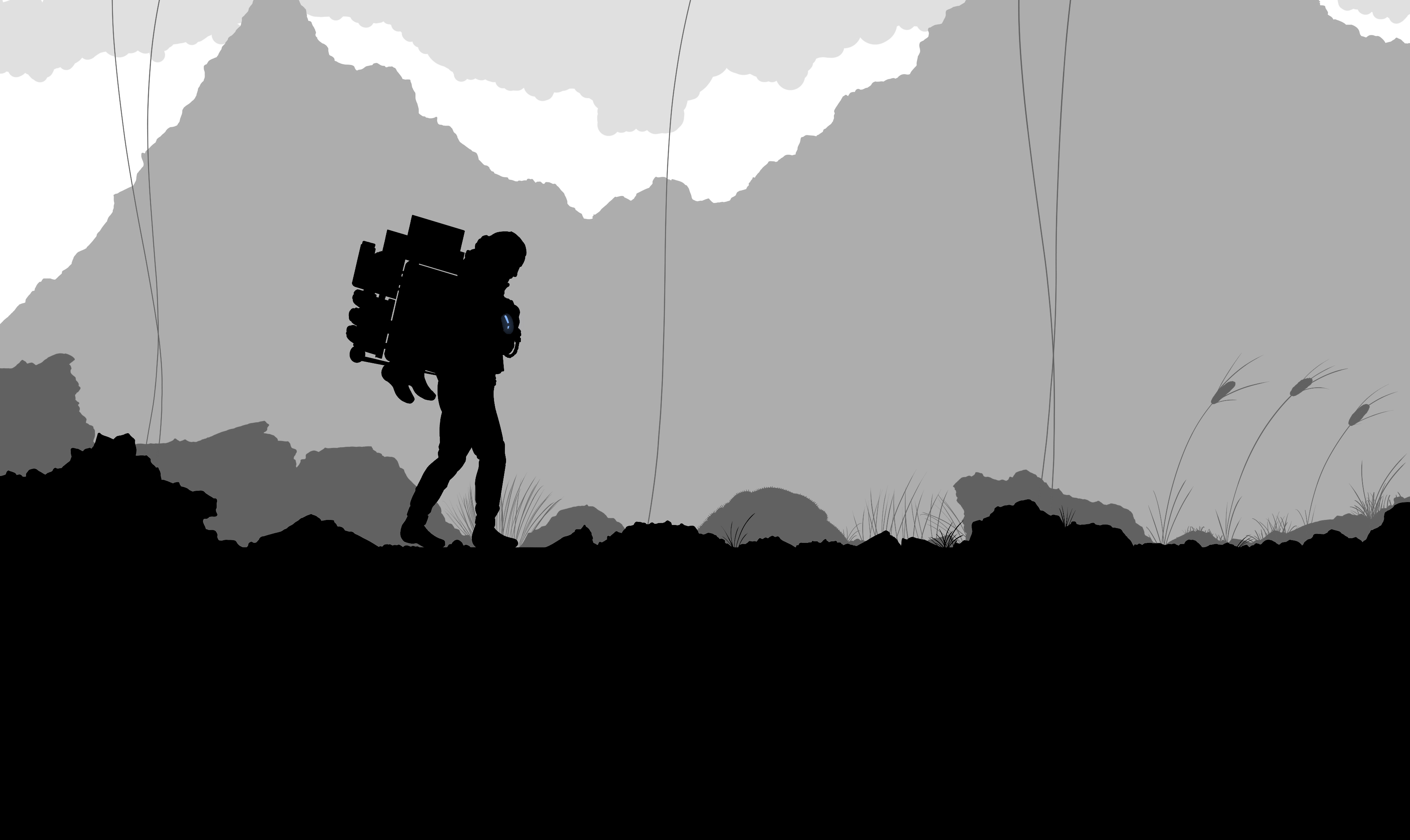
Part 1 – Plot Summary
Death Stranding has a complicated lore, story, and plot. Considering how much of my analysis is based on diving into the nitty-gritty details of this narrative, I want to lay out my understanding of the game’s entire story upfront.
The following is the most streamlined plot summary of Death Stranding I can write. My goal is not to cover every single event in the game’s universe, but to provide the bare-minimum of information needed to explain the logical connections of events before and during the game. Note that much of the following is based on single lines of dialogue or text in the “interviews.” If there are any problems with this summary, be sure to tell me in the comments.
This is What Happens in Death Stranding
Bridget Strand is born. Throughout her childhood, Bridget experiences nightmares of the apocalypse.
In her early 20s, Bridget gets uterine cancer, and loses the ability to have children. The disease forces Bridget’s soul (AKA “ka”) to leave her body (AKA “ha”) and become stranded on the beach. The beach is a space where the souls of dead people go before they move on to the afterlife. Every individual has his/her own beach, though sometimes massive beaches are shared by many people if they died traumatically and in a short timeframe (ie. war).
Bridget survives the cancer, but her soul does not return to her body on Earth. Thus two parallel Bridgets exist – one on Earth and one on the beach. The two Bridgets operate independently, but work towards common goals. Earth Bridget ages like a normal human, but beach Bridget remains in her 20-something form eternally.
Beach Bridget finds that her beach is connected to all other beaches (those of every living being in history). She explores these beaches and figures out that huge numbers of beings died during five distinct mass extinction events. These extinction events are caused by a large amount of antimatter flowing from the afterlife, through everyone’s beaches, and on to Earth.
The Bridgets deduce that they are an extinction entity, a being which causes extinction events by flooding the other beaches and Earth with antimatter through its own beach at the center of the beach network. The Bridgets set out to try to stop the next extinction event and try to save humanity.
Earth Bridget becomes vice president of the United States (!). She uses her power and resources to form Bridges, a research organization. Bridges studies “bridge babies” (AKA BBs), unborn fetuses taken from stillmothers (which are braindead pregnant women). BBs are uniquely connected between Earth and the afterlife, and Bridget believes they might reveal more about the Earth-beach-afterlife network to allow her to stop the next extinction event.
While messing around with a BB, some researchers in Manhattan accidentally trigger the first voidout, an antimatter explosion which annihilates everything in its vicinity.
Cliff Unger is a legendary special forces soldier. His wife, Lisa Bridges, is a stillmother. Cliff’s old war comrade, John McClane (AKA “Die Hardman”), is Bridget’s righthand man at Bridges (the research organization). John brings Lisa to Bridges and enters her unborn son into the BB program under the pretense of finding a cure for Cliff’s braindead wife.
Bridget’s research has a breakthrough. Due to a special property in this BB, Bridget figures out a way to use BBs to create a chiral network. Chirilium is a substance found on the beach which allows the instantaneous transmission of data and potentially physical material. A chiral network on Earth could permit the easy transfer of material from the beach to Earth. This could help facilitate the transfer of antimatter from the afterlife, through the beaches, to Earth. However, to create this chiral network, the special BB would have to be killed.
John betrays Bridget and tells Cliff that his baby will die. Cliff attempts to escape with his son but fails. On the orders of Bridget, John shoots Cliff, and accidentally hits the BB as well. Both Cliff and the BB die.
Out of guilt, Earth Bridget sends beach Bridget to rescue the BB’s soul from his beach. Beach Bridget sends his soul back to his body on Earth.
Though this saves the BB’s life, it also triggers the death stranding, essentially a breach between Earth and the afterlife via the beach. The death stranding changes Earth in many ways:
- When a person dies on Earth, his body enters necrosis, a 48 hour period at the end of which his soul returns to Earth as a beached thing (AKA “BT”). BTs contain antimatter, and if they consume living flesh, they trigger a voidout. BTs might also just randomly flow onto Earth, though it’s not clear.
- Chirlium was released into the Earth’s atmosphere. This creates timefall, which is precipitation (rain, snow, etc.) which causes aging upon falling on to organic matter.
- Black tar from the beach floods portions of Earth, especially in areas which have experienced voidouts.
The death stranding causes wide-spread civilizational collapse and the vast majority of humanity dies off over a few decades.
Earth Bridget takes Cliff’s BB as her own son and names him Sam Strand. Beach Bridget (who still looks like she’s in her 20s) begins posing as Sam’s sister under the alias, “Amalie.” Amalie takes Sam to her beach to spend time with him, though she cannot appear in physical form on Earth.
Due to Sam’s revival from death, Sam is a repatriate, meaning he can travel back to Earth from the beach when he dies, thereby making him functionally invincible.
At some point, the Bridgets begin sharing their nightmares of the apocalypse with random other humans via their beaches. The Bridgets believe this will give them a better perspective on the meaning of life and the moral value of their role in causing another extinction.
The humans who experience these nightmares are known to be afflicted with DOOMS. DOOMS also causes a closer connection with the afterlife which manifests as supernatural powers of varying types and strengths, including the ability to sense or see BTs, or travel to and from the beach at will. Sam is afflicted with DOOMS, as is Heartman, Fragile, and Higgs.
After the death of the US president, Earth Bridget becomes president and stays in power for decades as humanity declines due to the death stranding. The United States dissolves as populations retreat to isolated cities cut off from one another. Bridges is repurposed to rebuild the fractured United States.
Sam becomes a courier for Bridges. He’s tasked with transporting packages between isolated cities. Due to his DOOMS nightmares, Same begins seeing a therapist, Lucy. The two fall in love, marry, and conceive a child. The DOOMS nightmares spread from Sam, to the child, to Lucy. Lucy commits suicide. Her body necrotizes and the resulting BT causes a voidout which destroys an entire city.
Devastated, Sam leaves Bridges and becomes an independent courier with minimal human contact. He distances himself from other people as much as possible to live a lonely, miserable existence.
Bridget launches the first Bridges expedition to build a chiral network across the United States. Publicly, this is done to rebuild the US. Privately, Bridget wants to build the chiral network to link as many beaches as possible together, thereby granting Bridget access to even more data about the next nature of life and the universe throughout time, which will hopefully show her a way to stop the extinction event.
The first part of this expedition is run by Amalie. (This is very confusing and I don’t know how it makes sense, as I’ll elaborate upon later.) Despite supposedly not being able to take physical form on Earth without the chiral network, Amalie leads the first team across the country and builds the foundations for the transcontinental chiral network. She sacrifices BBs at distral centers to set up nodes for the network.
Along the way, Amalie meets Higgs, a local porter with DOOMS. She tells Higgs the truth about the death stranding and the impending extinction, and grants him an enormous boost in his DOOMS powers. Amalie gives Higgs a doll which allows Higgs to access Amalie’s beach. Rather than wanting to help Amalie in stopping the next extinction event, Higgs wants to cause it.
The second part of the first cross-country expedition is led by Heartman and Mama. They use a Q-pid to link the network nodes together. They almost complete the chiral network, but it does not stretch the very last facility on the west coast.
Enraged at Amalie not fulfilling her destiny of becoming an extinction entity, Higgs decides to hasten the end of humanity by destroying Bridges. He becomes a separatist terrorist and rallies other local dissidents to attack Bridges facilities. The disruption is so great that the chiral network falls apart and the individual cities and distral centers become enclaves, though a weak form of the chiral network still survives between all of them (which still permits communication).
Ten years after leaving Bridges, Sam returns to the remaining cities under the control of the American government on the east coast for a courier job. Possibly out of jealousy, Higgs tries to kill Sam with a voidout, and destroys a city in the process. Sam is killed but comes back to life.
Sam goes to the capital city and finds that his mother is still the president. John McLane, rechristened as “DieHardman,” is Bridget’s second-in-command. Bridget tells Sam she is dying and asks Sam to lead a second transcontinental Bridges expedition to rebuild America and the chiral network. Sam initially refuses.
Bridget dies, and Amalie (posing as her daughter) becomes the next president. However, since Amalie can only assume a holographic form on Earth via the chiral network, she pretends that she has been captured by separatist terrorists, is being held on the west coast, and therefore is communicating to Sam through the chiral network. She asks Sam to lead the second Bridges expedition and rescue her. Sam agrees to do so.
Sam is given a Q-pid to relink the chiral nodes. Sam is also given a BB, whom he calls “Lou.” Though BBs are primarily used to launch the chiral network, this purpose is kept secret from Bridges and its staff Bridget/Amalie. Instead, most BBs are used as BT detection devices. Usually BBs don’t work with individuals afflicted with DOOMS, but Lou does.
Sam travels across the eastern part of the US until he is confronted by Higgs again. Higgs deploys a large BT to kill Sam again, but Sam defeats it. Higgs continues to attack Sam and his allies as he continues traveling west.
Due to damage caused by Higgs, the Bridges facilities are too weak to hold up the chiral network themselves. So throughout the middle of the country, Sam is forced to build chiral connections with local preppers, or individuals who survived the death stranding in their own private bunkers. To gain access to the preppers, Sam relies on Fragile, the head of the independent courier service, Fragile Express, and a former partner of Higgs.
At some point, Amalie uses her power to locate Cliff (who is presumably in the afterlife). She gives him a doll like the one she gave HIggs which allows Cliff to use Amalie’s beach. It also allows Cliff to gain access to Earth. Amalie does this to let Cliff reach out to Sam so that Sam will eventually learn the truth about who his parents were and that he wasn’t abandoned by his father. Amalie believes this will boost Sam’s commitment to reform bonds with other people and rebuild America.
While travelling, Sam periodically encounters massive chiral storms which are manufactured by Cliff. Sam is sucked into these storms and lands in beaches created by the concentrated deaths of major wars. Cliff uses Amalie’s beach to access these beaches and attack Sam to get to Lou, whom Cliff mistakenly assumes is his son. However, Sam always fights off Cliff and holds on to his BB.
Sam makes his way across the US and arrives at the second-to-last Bridges facility on the west coast. Sam picks up a new BB there and delivers it to the final facility to be sacrificed to create the last structure in the chiral network, and then uses his Q-pid to complete the network.
Higgs attacks Sam again, and is defeated. Higgs uses his DOOMS powers to kidnap Amalie and bring her to her own beach with the intention of forcing her to trigger the extinction event. Sam uses Fragile’s DOOMS powers and a qipu Amalie gave him to follow Higgs to Amalie’s beach. Sam defeats HIGGS and then turns him over to Fragile so she can get revenge.
Amalie confirms to Sam that she is an extinction entity and then throws him out of her beach and back to Earth. (A whole bunch more happens here, but as I’ll explain later, I don’t think any of it makes sense, and it ultimately doesn’t impact the story anyway.)
Sam travels all the way back across the US to the east coast to reunite with Fragile and most of the rest of the Bridges team. They decide that they must send Sam back to Amalie’s beach to either kill her or convince her to stop the extinction event. Fragile uses her powers to send Sam to Amalie’s beach.
Once Sam had established the transcontinental chiral network and rescued Amalie from Higgs, Bridget/Amalie could explore the full dearth of knowledge unlocked by the enlarged chiral network. She discovers that the Big Bang, which created all matter in existence, was a random incident that threw the universe out of balance since it led to the creation of all life. In response, the universe is trying to destroy all life to return to balance. The periodic extinctions of all life are an evolutionary mechanism to force life to evolve so that it can become more resilient and survive the universe’s attempts to permanently destroy it.
With these insights, Bridget/Amalie decides to cause the extinction event.
On her beach, Amalie explains to Sam her motivation for trying to cause the extinction event. Amalie then offers Sam a choice between watching the next extinction event with her, or killing her to hopefully cut her beach off from the others, thereby potentially stopping the extinction event. Rather than choose either option, Sam hugs Amalie. The connection between them inspires Amalie to cut her beach off from the other beaches, and stay trapped on her own beach where she can manually delay the extinction event for as long as possible, though not eternally.
Sam returns to Earth. With no connection between Amalie’s beach and the other beaches, the death stranding ends. DieHardman becomes the president of the new United Cities of America.
Lou appears to die. Sam takes Lou to an incinerator to dispose of his body. Along the way, Sam receives visions of his birth and learns the truth about Cliff being his father. Sam takes Lou out of his BB tank and brings him to life with CPR. Realizing Lou is a girl, Sam calls her “Louise.”
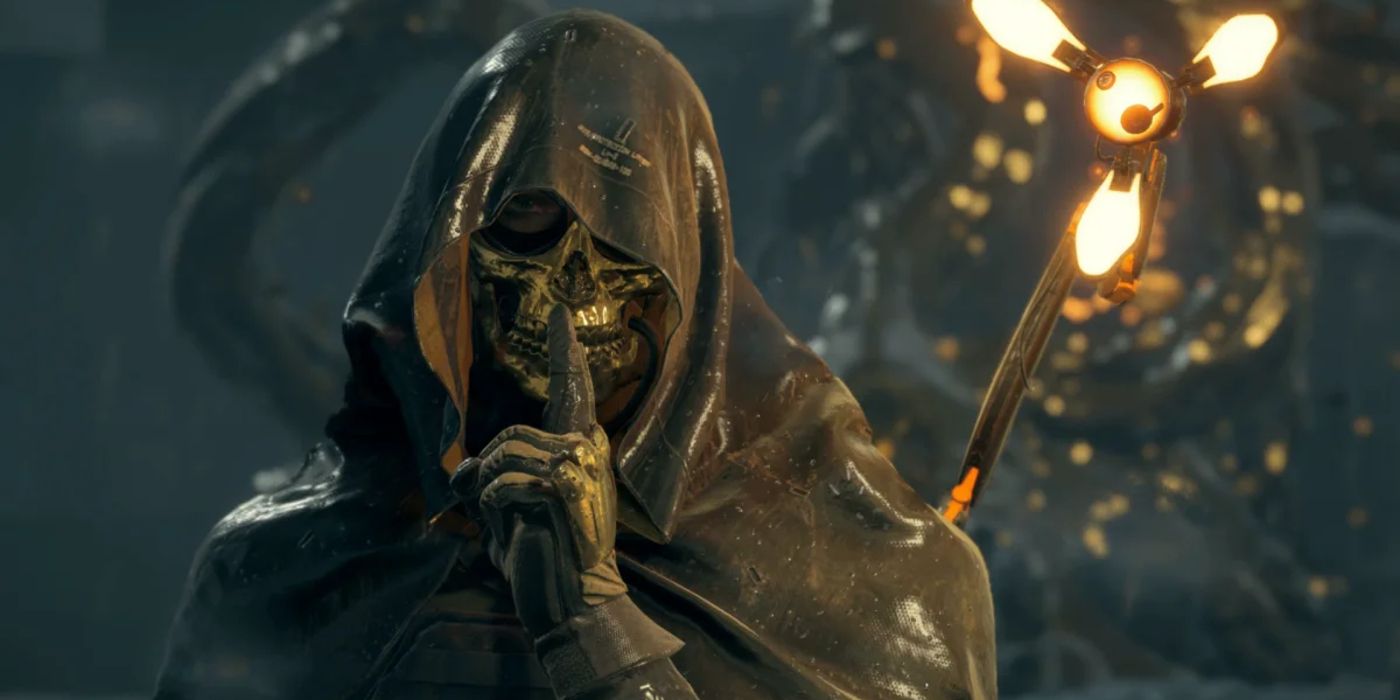
Part 2 – The Genius in Death Stranding
I want to reiterate here that there’s a lot of greatness and beauty in Death Stranding. Kojima is a true auteur and has created a wonderful game which pushes the entire artistic medium forward.
I’m repeating this because I’m going to say a whole lot of negative things about Death Stranding. But before I get to that, I will summarize as briefly as possible what Death Stranding does right:
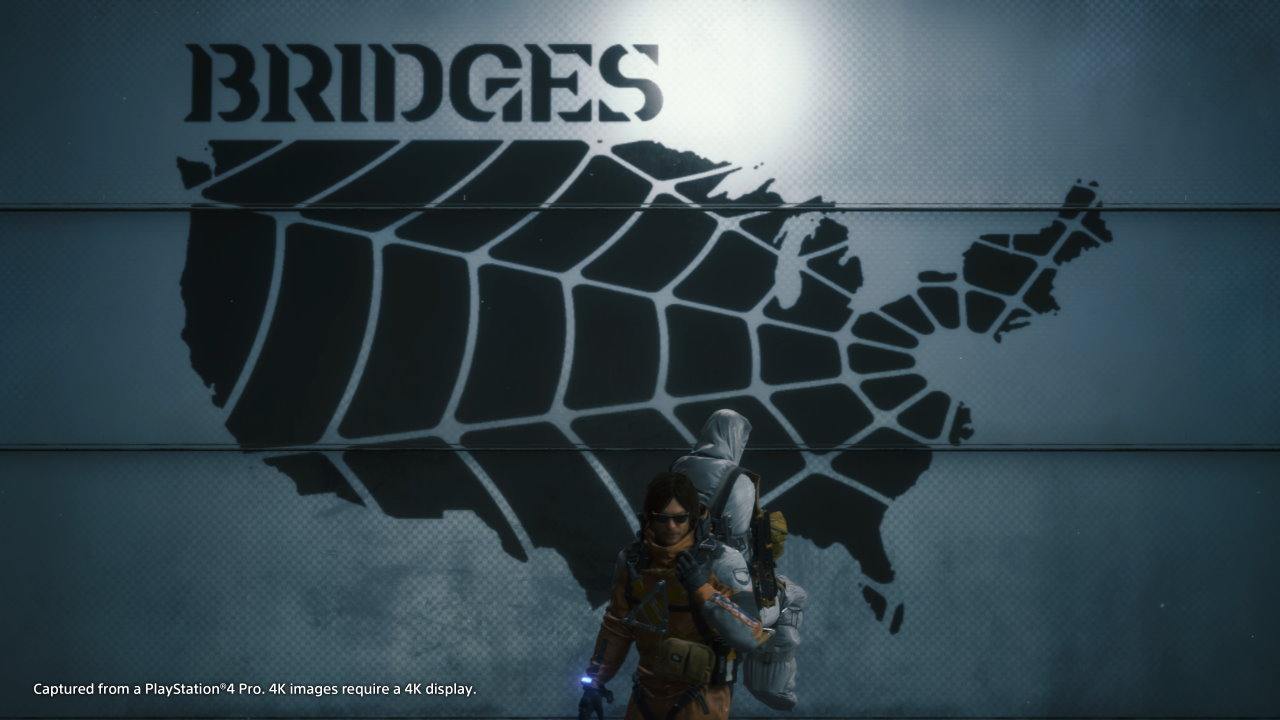
Strand-Like Genre
Kojima’s conception of a “strand-like” game is a fascinating step forward in game design. Kojima invented stealth games with Metal Gear, and now he’s invented stand-like games with Death Stranding. We’ve all played a bajilion games where we fight Nazis, monsters, aliens, mutants, etc., but so rarely do we play games where we build something or try to connect people. Or even if our ultimate goal is building or connecting, we usually achieve this by fighting. We take sections of the map by destroying bases, or build settlements by killing bandits and taking their resources, etc.
But not in Death Stranding. This is a game based on travel, trade, logistics, and good will. It is a truly novel twist on one of the most fundamental aspects of gaming, and I can’t wait to see what comes next from it.

Lore and Grand Worldbuilding
I have never seen or read of a world like that of Death Stranding. Kojima deftly walks the line between sci fi and fantasy again with a huge, fantastical universe with complex rules, fascinating implications, and totally fucking cool concepts. It was a joy to unravel the mysteries of the death stranding and the unfortunate America it destroyed.
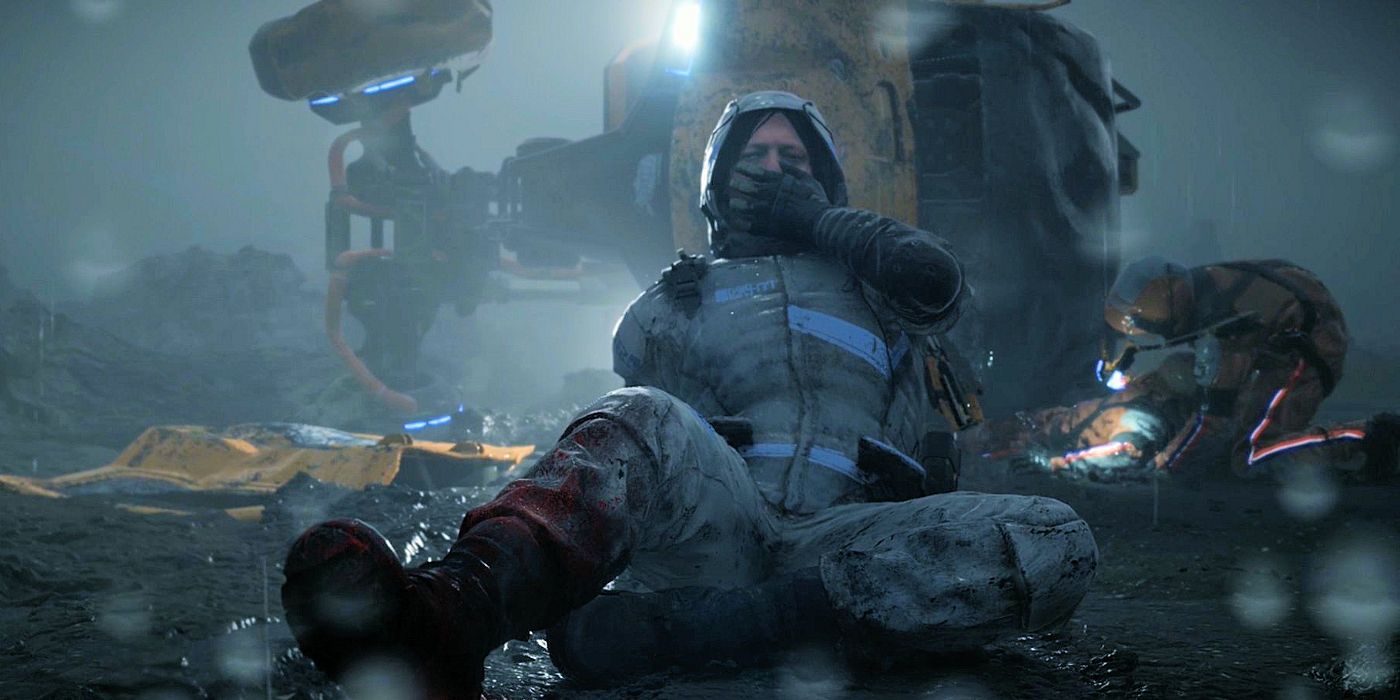
Directing
Kojima is famously/infamously infatuated with filmmaking. Fortunately, he has (somewhat) moved past a lot of the stilted cinematography of his earlier games, and is getting better and better at truly dynamic filmmaking. Death Stranding contains some of Kojima’s best direction ever. The first voidout scene (starting at 7:03) is a masterpiece, all of Cliff Unger’s entrances are fantastic, and even though it’s cheesy as hell, I love all of Higgs’s scenes too.

Characters and Actors
Though I don’t think Death Stranding has as characters as the Metal Gears, there are still some excellent character concepts, whether it be Heartman’s tragic search for his family, or the weirdness of Amalie/Bridget, or the psychotic megalomania of Higgs. Excellent acting (probably the best Kojima has gotten) picks up a lot of slack, especially due to the performances by Norman Reedus, Mads Mikkelsen, Troy Baker, and Margaret Qualley. Reedus in particular injects a lot of subtlety and interesting mannerisms into what could have been a bland protagonist roll.

Gameplay
Like so many players, I was shocked at how much I enjoyed Death Stranding’s gameplay, and I still can’t believe I didn’t grow bored of it. They way Kojima handles basic movement may very well be even more revolutionary than the strand-game concept. Again, Super Bunnyhop’s video does a great job explaining this in-depth.

Environment/Atmosphere
Death Stranding has an incredibly strong sense of feel. Playing the game simply feels like nothing else. The combination of the beautifully crafted environment, slow pace, steady gameplay, and ambient music all contribute to one of my favorite game worlds ever.

Music
I’m no expert on music, but the soundtrack by Ludvig Forssell (who also did the music for MGSV) works perfectly with the omnipresent Low Roar songs to further contribute to Death Stranding’s utterly unique feel. I felt chills every single time a Low Roar song came on while Sam was walking down a rocky hill overlooking a wondrous vista.
/cdn.vox-cdn.com/uploads/chorus_asset/file/19366349/monster.jpg)
Kojima Wackiness
Sauna baths, sticky guns, MULEs, Monster energy drinks, beer, toy soldiers, Ludens Fan, Conan O’ Brien, otter hat… it’s a Kojima game. Wacky stuff happens. It’s fun.
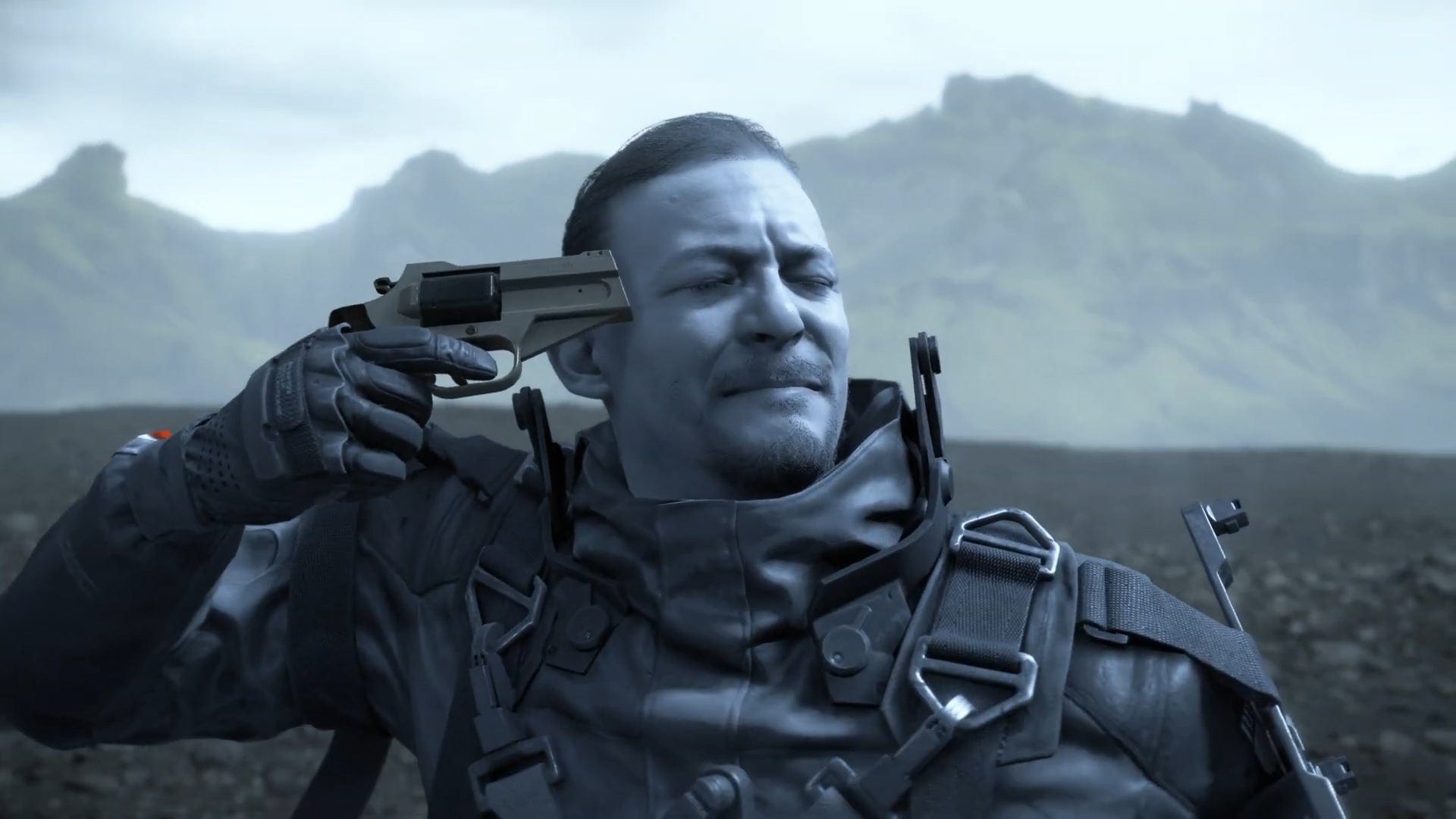
Part 3 – The Opposite of Genius in Death Stranding
And now that’s I’ve bullet pointed all the good in Death Stranding in a far too succinct manner that doesn’t do it justice… let me explain all the bad in Death Stranding.
Worldbuilding – The Broken Foundations
The biggest, highest concept aspects of the worldbuilding in Death Stranding are great. The death stranding, timefall, beaches, and fundamental shake-up of reality form one of the most unique settings in video game history.
But the worldbuilding on the level below these big concepts is terrible and drags down the entire story.
Despite all the stuff about beaches, and seams, and death strandings, and extinction entities, the bulk of Death Stranding is spent making deliveries to distant, isolated settlements in an apocalyptic wasteland in the hopes of reuniting the survivors of humanity under a single banner. Yet, despite the whole game focusing on bringing people together (both literally and thematically), I never got a sense of who these people were or what being reunited meant. Death Stranding’s world doesn’t feel “lived-in” and its people are hollow.
While replaying the game, I was reminded of this great bit of analysis from Shamus Young’s essays on Fallout 3:
“Imagine a version of Skyrim where somebody keeps telling you that the world is being destroyed by dragons, but you never actually see a single dragon anywhere in your travels. Instead there’s just a lone singed peasant outside of town who tells you he needs a health potion because he was attacked by a dragon, and he always needs a health potion no matter how many you give him, and he’s the only guy in the world that seems to have a problem with dragons. That’s Fallout 3.”
Sam’s main objective throughout Death Stranding is to reunite America. Multiple characters in the game (especially DieHardman) hammer the importance of this goal into Sam over-and-over again throughout the game. But after playing the game twice, I’m still not sure what America is, or why I should care about it.
Death Stranding isn’t quite as bad in this regard as Fallout 3. Sam’s delivery missions usually include a subplot about how an outpost needs some good to accomplish some function, and Sam always gets thanked after each delivery so we get some sense of its importance.
But it’s all very abstract. There’s lots of talk about the value of Sam’s work, but aside from a few minor character moments, the game world and population never or barely change as a result of Sam’s actions. I, as the player controlling Sam Porter Bridges, never see or feel the impact of my efforts on the people of Death Stranding’s America.

America
America is a big deal in Death Stranding. The game takes place in America. The entire goal of the game is to rebuild America. Two key characters are presidents of America. Kojima uses America as the personification of humanity coming together to remake connections and communities for the sake of survival and prosperity. America is everything.
Yet there’s this gaping emptiness to Death Stranding’s America. Like most countries, the United States has its own history, culture, mythology, unique government structures, etc. Dare I say, the United States is a particularly unique country by global standards given recent history.
Yet, if you replaced every mention of “America” in Death Stranding with “Japan,” and then made most of the characters Japanese, nothing in the story would change.
This America that Sam is supposed to rebuild, that the player is supposed to care about, is not recognizably American in any capacity. Yes, there is a president, but there is no Congress, no Supreme Court, no states, no mention of a Constitution or the Declaration of Independence, or any legal structure. All decision-making power seems to rest in the hands of the president and her second-in-command. When the president dies, her daughter becomes the next president. There’s no voting or electoral process, she’s just appointed by DieHardman, who doesn’t even have a government title. So I guess the presidency is a hereditary monarchy, or at best, it’s chosen by some sort of oligarchic council. How very American.
Kojima is big on symbols. Prior to the launch of Death Stranding, he constantly tweeted about the concept of “strands” being a tool of connection, but “stranding” being a failure of separation. He mused about the dichotomous “rope and stick” being the first tools of civilization – one unites, the other divides. The game itself is packed full of imagery and references to these themes: strands dangle in the air to connect the Earth and the afterlife, “bridges” serves as the name of the organization reuniting America and Sam’s dead mother, umbilical cords function as multiple crucial plot devices, etc.
So what symbolism does Kojima use for America, the crucial motivating goal of the entire game?
Well, there’s an American flag in Bridget’s fake oval office. And the “United Cities of America” logo has stars (but no stripes). But that’s about it. In none of America’s many government facilities and cities do we see anything else representing America. There are no images of eagles, past presidents, the Capitol building, the White House, the Statue of Liberty, the Liberty Bell, Mount Rushmore, the Pentagon, etc. There’s never a red, white, and blue color scheme. One would think that the grand unifying force to bring everyone in America back together would have a bit more gravitas.
There’s also no sense of American ideology or mythology. There’s no talk in Death Stranding about the value of life, liberty, and the pursuit of happiness. No one discusses the proper limited role of government in this new world. There isn’t the slightest pretense towards democracy or representation.
There are no American locations in this America. Even though the events of the game take place only a few decades since the start of the death stranding, names like New York, Washington DC, and Chicago have seemingly faded into the fog of ancient history. Instead we’re given an array of monotonous, confusing, boring names like “Edge Knot City,” and “Lake Knot City,” and of course, “Mountain Knot City.” Why not name the cities after Americana iconography? Why not name them “Jefferson City” or “Constitution City?” Is the rope metaphor really that important to shoehorn in here?
Even the land itself is not American. As in, none of the terrain in the game you spend dozens of hours traversing looks anything like the continental United States. The geography of Death Stranding was clearly based on Iceland, which is beautiful and otherworldly, but certainly not American.
There is nothing to this America. It doesn’t have an American government, American symbols, American values, American culture, or American land. It’s just a generic governmental organization with an existing country’s name. From a plot perspective, it would have made more sense just to call the organization “Bridges” since it and the “UCA” have so much overlap anyway.
But even if the game tossed “America” aside and just asked the player to reunite some fictitious land under some made-up organization, it still wouldn’t work because…
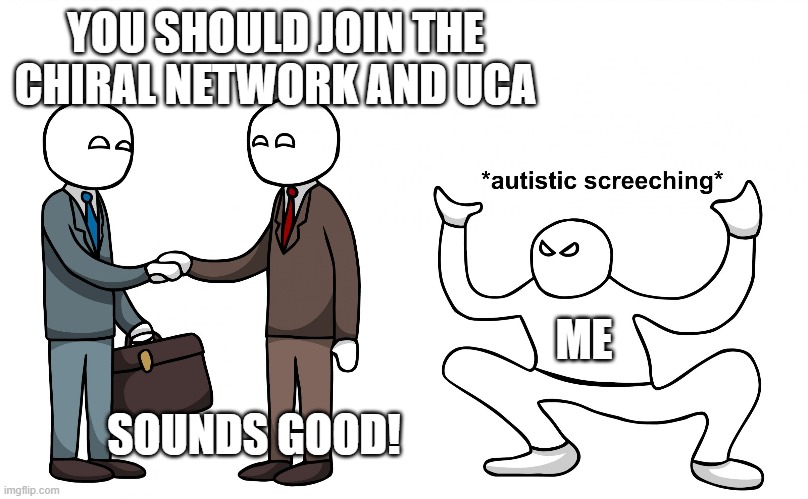
Economics
The economics in Death Stranding are annoyingly vague and nonsensical.
This might sound like an incredibly pedantic complaint, but I don’t think it is. The entire game is based on logistics, it should have put at least the slightest thought into how logistics work.
This is especially disappointing because the logistics focus is one of the best parts about Death Stranding – it’s a radically different take on some familiar gameplay tropes. If Kojima had come up with the “death stranding apocalyptic world” concept and handed it off to some generic video game designer, we would have gotten a game where Sam uses “anti-death guns” to go out and “kill” stranded ghosts to “reclaim” portions of the overworld map to build bases, and it would have been just another generic open world shooter. But instead Kojima did something extremely different, and interesting, and somehow made a game about making long, slow, largely uneventful on-foot deliveries… fun.
Unfortunately, the UCA, the deliveries, the courier system, the “likes,” the chiral network… none of it even attempts to make sense.
Sam strolls up to a prepper’s bunker and says, “here are some extremely valuable materials that you desperately need. I would like you to join the United Cities of America and the chiral network. In doing so you will continue to get more extremely valuable resources. And you’ll gain access to a cross-continental communications network which will keep you safe and relieve the dire boredom you’ve experienced by interacting with only one other human being for the last ten years. Do you accept?”
If I were a prepper, I would ask, “ok, that sounds interesting. But what is the cost? Do I have to pay taxes to the UCA? Do I have to pay upkeep costs to maintain my portion of the chiral network? Am I obligated to use my productive specialty (engineering, doctoring, or whatever) to help other people in the UCA? If so, how much do I have to produce? Am I going to have to work 12 hour days building widgets to maintain my place in this very valuable network? Oh, and how much does this delivery cost anyway? And how much will my next delivery cost? You see, I’m a humble prepper living with my wife in the middle of nowhere, I don’t have much of value left in my bunker, and-”
And what about the UCA’s economic calculus? Is it financially feasible for the UCA to bring every single prepper into the network? What if the cost of delivering goods to the prepper isn’t worth the value of what he produces? Or what if the prepper doesn’t produce anything of value? What if there’s competition between cities over scarce resources? Whit if both Lake Knot City and Mountain Knot City want to make a huge order from the engineering prepper? Who gets the order? And will the new random prepper brought into the UCA ever get his engineering order fulfilled if the larger, more established cities are already making orders? And-
Oh, wait, forget all these questions. it’s all free. All the transportation, all the deliveries, all the power, all the goods and services, all of it is free. The prepper gets all those benefits and it costs him nothing. The UCA provides goods and services and it seemingly costs nothing. Everyone gets access to the chiral network and it doesn’t cost anyone anything. Milton Friedman was wrong; free lunches do exist.
Again, I know this seems like the most pedantic harping, but the entire game is about logistics. The whole game consists of setting up supply lines and nation-building, but the subject of “cost” is never even mentioned.
As with Death Stranding’s concept of “America,” the lack of even the most simplistic broaching of economic analysis makes Sam’s mission feel hollow. It undermines the very awesome core idea of rebuilding America and turns it into a bunch of nonsensical fetch quests. It makes the preppers Sam painstakingly coaxes into the UCA seem stupid. Speaking of which…

Preppers
The preppers are probably my least favorite part of Death Stranding.
When Death Stranding was in development and Kojima was posting a million photos on Twitter of him working with Norman Reedus and Mads Mikkelsen, there was this meme joke going around that Kojima just made the game as a ploy to hang out Hollywood celebrities. I mean, Helen Mirren showed up to a Death Stranding art gallery event.
I don’t think the joke is accurate, but the preppers… they do make me wonder. Most of the preppers and distral center guys are celebrity cameo. I didn’t recognize them during my first playthrough, but Edgar Wright (director of Shaun of the Dead/Hot Fuzz), Jordan Vogt-Roberts (director of Kong: Skull Island), Geoff Keighley (video game host guy), and Conan O’Brien, all make appearances. Many others are played by semi-famous video game journalists, musicians, fashion stylists, etc.
There’s nothing wrong with cameos. But maybe half of Death Stranding’s cast consists of cameos. And both the performances and writing of these parts are unbelievably bad.
Seriously, I don’ know how this happened. Kojima has plenty of storytelling flaws, but character design has never been one of them. In fact, it’s always been one of his greatest strengths. He’s a master at crafting cool heroes, fascinating villains, and fun supports. Think of how many memorable bit villains exist in the Metal Gear series – Psycho Mantis, Vamp, the End, Revolver-fucking-Ocelot, etc. Every minor character in Kojima games has obsessive detail put into their appearance, outfits, movement, voice acting, and backstory to create some of the most iconic video game characters of all time.
So why are all the preppers and distral center guys in Death Stranding so fucking boring? Why do they all talk in the same slightly enthusiastic monotone? Why do they all have the exact same chipper reactions to Sam for every single delivery? Why do they never, ever have anything interesting to say or do? Why can’t I remember a single thing about 90% of them besides their bland functional names (ie. “doctor” or “craftsman”)? Why was so little thought and effort put into the characterization of the characters we spend the majority of the game interacting with?

Take a step back and consider what the “preppers” are in Death Stranding.
The preppers are individuals or groups of individuals who built their own survival bunkers before or during the start of the death stranding and endured the collapse of America, civilization, and humanity in almost complete isolation. They are the last people left alive on Earth outside of a handful of UCA cities. If you had to guess how these people would look, sound, and act based on that description, what would you picture?
Would you think of this guy (35:10)?
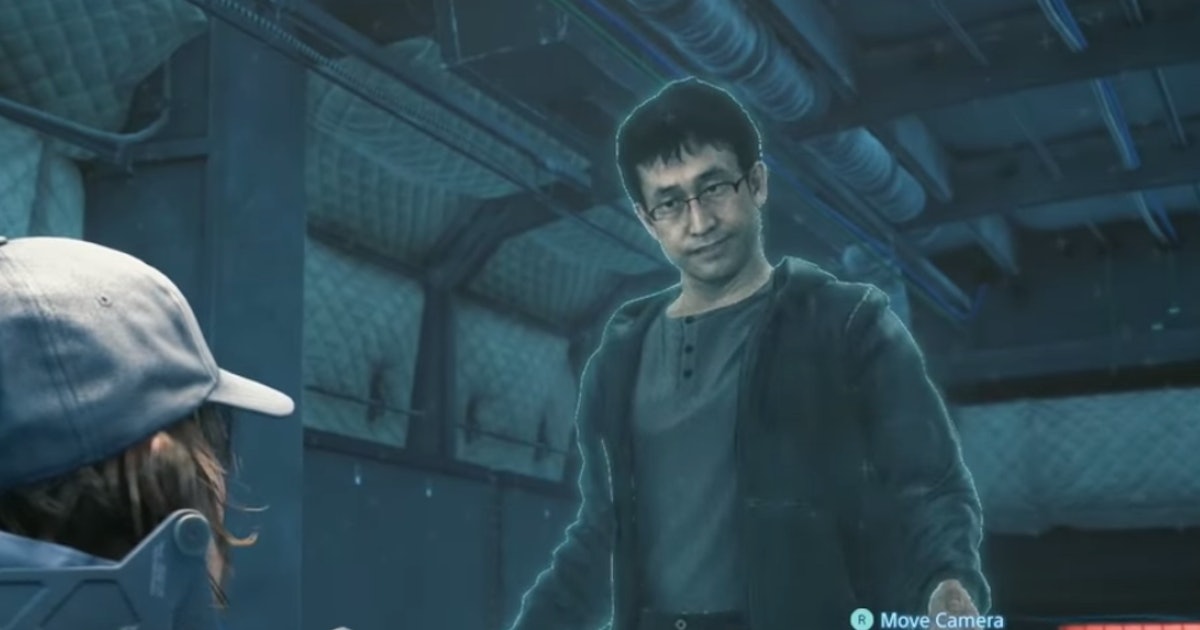
Does anything about this character indicate that he’s the type of person who obsessively prepares for disaster to the point of constructing or buying his own bunker? Does anything about him make you think he lives alone in a bunker in an apocalyptic hellscape and hasn’t seen another human being in years? Does he present as eccentric, paranoid, brilliant, or any other quality associated with his extraordinarily unusual circumstance?
Nope, not at all. After being built up through multiple conversations, after being told by DieHardman and Fragile about how intrepid and difficult and cautious and wild the preppers are, they turn out to be the blandest, boringest, milquetoastiest characters in any Kojima game ever. And the UCA distral center guys who work for a post-apocalyptic government revival movement resettling a collapsed frontier overrun by ghosts and feral deliverymen are just as incredibly uninteresting.

What makes this worse is that the preppers are used in a really great set up in the plot. The cross-country chiral network was initially established based on UCA cities and distral stations, but with the destruction wrought by the separatist terrorists, Sam had to somehow convince the unaligned preppers to join the UCA! Both DieHardman and Fragile tell Sam how much of a challenge it’s going to be to wrangle all these suspicious, fiercely independent weirdos together into a community.
Based on this premise, I assumed I’d be encountering an array of post-apocalyptic crazies ready to blast me off their bunker front porch with a shotgun. I didn’t think the preppers would be quite as wacky as the various characters the player meets throughout the wasteland in the Fallouts, but something along that vein. You know, individuals who have crafted their own lifestyles, cultures, and ideologies based on the odd personalities that made them preppers in the first place and the particular environmental challenges they’ve faced since the start of the death stranding.
But nope, there’s none of that. Every bunker looks exactly the same. There aren’t different structures or color schemes, and no one has attempted to decorate them. Almost everyone speaks exactly the same (ie. in ordinary non-post-apocalyptic 21st century parlance). No preppers are deranged paranoids who shoot you on approach out of fear that you’re a terrorist, some kind of new BT, or a manifestation of their isolation-induced psychosis. None are so incredibly thrilled to break the crushing loneliness of their endless isolation that they immediately invite you inside their bunkers and talk your ears off for hours. Everyone reacts to the arrival of one of the only people they’ve seen in years the same way they’d react to finding a $20 bill on the ground. They’re all just like, “oh, hey, nice, a delivery, thanks, see you around.”
It all feels so incredibly lazy. Linking the preppers to the UCA is a major plot point and takes up a huge chunk of the middle of the game, and yet it feels like the whole concept was written off as a joke. The writing and dialogue are painfully flat (I desperately struggled not to skip it all on my second playthrough). The actors are mostly cameos from celebrities that Kojima presumably finds interesting and wanted to meet, rather than legitimate voice and motion cap actors. Even a significant portion of the identifying jobs of the preppers are silly jokes. I mean, I’d expect a doctor, engineer, and farmer to survive the apocalypse, but “Film Director?” “Cosplayer?” “Musician?” “Novelist’s Son?” “Photographer?” “Ludens Fan?” One joke prepper is fine, but this many reeks of lackadaisical storytelling.
The only preppers who aren’t painfully boring are quite literally the worst characters in the game… the “Junk Dealer” and “Chiral Artist.” Kojima has been called tone deaf many times before, but these two preppers are maybe the tone deafest thing I’ve ever seen in any story ever.

The first scene where you see the recording of the Chiral Artist is just plain bizarre, but not in a good way. It’s shot like a horror movie, with the hazy marionette music and a confused child playing with some sort of toy presented through a static-y hologram. It legitimately looks like something out of Bioshock.
Before that scene, the Junk Dealer (who is just as boring as the rest of the preppers on his own) laments the recent death of “his girl.” So I, and presumably every single other Death Stranding player, assumed this unnerving hologram of a strange child stumbling around was his daughter who must have been killed in some gruesome way. I thought she looked a little too old for her childish behavior (maybe she was 14 or 15?), but whatever. Later, this incongruity is ramped up when the player meets the girl and she speaks with a very childish accent, like she has trouble forming words.
But then the unsettling display soars to full-fledged creepiness when it’s clarified that the little girl is the guy’s lover. Of course, she isn’t meant to be a little girl, but the actress who plays her is a rather young-looking Japanese model with an accent that makes her sound even younger.
So… the chiral artist looks like she’s 14, acts like she’s 8, but is actually in her 20s (?). That means she must have grown up in the prepper bunker with her mother, and then fallen in love the Junk Dealer, and then moved in with him to live in his bunker in total isolation when she was how old…?
Instead of this scene playing out like a creepy horror story about an older man kidnapping or/brainwashing a child to live as his sex slave, it’s presented as a tragic romance.

Absolutely everything about this subplot is a disaster – the quasi-pedophilia, the shallow writing, the atrocious acting, and worst of all, the blaring tone deafness of how bad it is. Clunky writing aside, Kojima has always been an excellent creator and director of actors. The performances we get from Reedus, Mikkelsen, and the rest are strong across the board. I’m stunned that this thing made it past the game testers.
But at least I remember the Junk Dealer and Chiral Artist. I can’t tell you a single thing about the “Paleontologist,” “Evo-Devo Biologist,” or “Mountaineer.” That’s all Death Stranding does with the fascinating prepper concept – dozens of incredibly boring characters and two horribly tone death “creepy-in-the-wrong way” characters.
And beyond the prepper, I’m left asking…
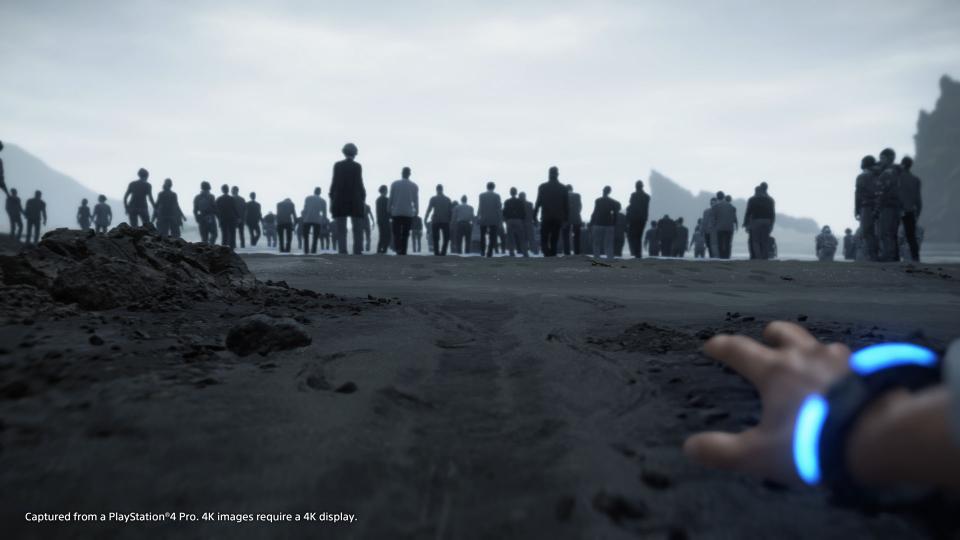
Where Are All the People?
Season 8 of Game of Thrones was terrible. I don’t think that’s a controversial opinion.
But one of the underrated problems with the season was the complete lack of new characters. One of the show’s greatest strengths was its epic scope. The world felt alive because there were so many key characters doing so many things in so many places. Every little piece of the map had its own local culture, local lords, local power structure, etc. Every time a new character from some far off land was introduced, Westeros and Essos felt just a little bit bigger and more real. The introduction of Oberyn Martell from Dorne in season 4 is a perfect example.
But in season 8, there were no new characters. The vast continents of the show seemingly shrunk. It was difficult to feel that there were millions of lives at stake when the entire world seemed to consist of a dozen individuals sitting in two castles.
Death Stranding has the same problem, but even worse. The player is constantly told that America and the entire world depends on reconnecting the chiral network, yet we never see the people we’re supposedly helping.
How many people live in Death Stranding’s America anyway? Hundreds? Thousands? Millions? Who are they? Are they political elites who clustered in the last safe spaces away from the BTs? Are they military personnel and their families who had the technology to stay alive? Are they just random lucky people who were in the right place at the right time?
Do they all work directly for the UCA? Is there still a civil society left? Do they all have pragmatic jobs in the military, engineering, food production, etc., or are there still enough resources for arts, sports, and leisure?
Do the people constantly pine for the old world lost to the death stranding? Or have they established a new culture based on what they have in front of them? Is there a cultural divide between the older people who lived most of their lives before the death stranding and those who lived most of their lives during it? What do the people think of Bridges’s cross-continental expeditions to reunite America? Do they love the symbolism of bringing the American people back together? Do they approve of such a heavy expenditure of resources? Did they have any say in the matter? Do they support their president? Do they support her mysteriously masked second-in-command? Does anyone besides the guys working in the distral stations know who Sam Bridges is?
I am not saying that Death Stranding needed to tackle all these economic, political, cultural, and sociological questions. But the driving motivational force of the entire story needed some substance. The player needs some sense that there actually is a country full of people he’s trying to help, and that these people are sentient beings the player should care about rather than some vague, unseen abstraction called “America.”
And no, I don’t think the preppers adequately fill this role. We do see how the chiral network and UCA positively impact them (ie. Sam brings medicine to save the Mountaineer’s wife, Sam fixes the timefall farmer’s production problem, etc.), but it always feels like an isolated incident. Like, I’m helping one random guy in the middle of nowhere who lives alone in a bunker. There’s not enough of a conceptual connection between that and the effect of rebuilding America on the tens of thousands of people in Capital Knot City.
We basically don’t see people in Death Stranding. We see individual persons quite a lot, but there are precious few moments in the game when we see a legitimate group of people, let alone a crowd. Seriously, can you think of which cutscene or moment in Death Stranding has the most human beings on screen at once?
I haven’t actually counted the individuals, but there are only two contenders. The first is this scene when Sam first goes to meet President Strand (57:02), and we see some scientist-looking people walking through the hallways. The second is this scene where DieHardman announces the reunification of America to a small crowd in the presidential office. There is also the scene of Heartman on the beach (10:40), but that doesn’t count since everyone is dead and no one speaks.
So, that’s one scene at the very beginning of the game where we briefly see a somewhat busy working area, and one scene at the very end of the game where maybe a dozen people listen to the president in a small room. And that’s it. Those are the only times we ever see groups of people in Death Stranding, even though the entire game is about helping/saving a big group of people.
Like so many of these worldbuilding elements, this feels like a colossal missed opportunity because one of the major themes in Death Stranding is the pain of isolation. Some missions involve delivering drugs to outposts to help the people manning them fight through isolation-induced depression. The driving impotence of the entire rebuilding America operation is to bring people together and end the universal isolation. Sam’s whole character arc is based on him getting emotionally closer to people until he voluntarily ends his own self-isolation.
Imagine if after a grueling 40 minute delivery through the vast emptiness of post-apocalyptic America, past the crazed MULEs and through BT-infested territory, the player arrived with Sam in a glowing, lively city. Imagine a crowd of people coming out to greet him. Delight shines from their faces as they see Sam carrying boxes and they rush over to him with giddy excitement at what long-awaited packages might arrive. What better way to emphasize the pain of isolation than to contrast the loneliness of Sam’s solo treks against the warmth of the communities of people in the cities, distral stations, and prepper shelters that he strives to help?
But nope, none of that happens. Instead, Sam arrives in cold, mechanical warehouses. Nobody bothers to come down and greet Sam even though (I can’t emphasize this enough) seeing new human beings is an extraordinarily rare event in this world. Instead, the prepper or some random logistics worker broadcasts himself to Sam, receives the package, thanks him, and that’s it.
Again, this lack of any sort of depth or presence of the people whom Sam is supposed to be helping terribly undermines much of the core thematics of the game. Bridget, Amalie, DieHardman, and Deadman keep hammering Sam over and over again with “YOU HAVE TO REBUILD AMERICA, YOU HAVE TO TIE EVERYONE TOGETHER AGAIN, IT’S THE MOST IMPORTANT THING IN THE WORLD,” but I, as the player, kept wondering why Sam should give a fuck about these people. He can’t see them, he never talks to them, and they never do anything. The American people may as well be packed into stasis pods underground to wait out the death stranding.
/cdn.vox-cdn.com/uploads/chorus_image/image/65693482/death_stranding.0.0.jpg)
Plot – What is Going On?
Death Stranding’s plot is bad.
Death Stranding’s story is a mixture of lots of good and bad. There are incredible concepts, some good characters, and some great moments. But the plot, as in “the sequence of events” in the story, doesn’t work. It’s clunky, convoluted, badly paced, confusing, frustrating, and ends up being far less than the sum of its parts.
It took me a while to come to this conclusion. When I first finished the game, I wasn’t sure how to feel about it. The final few chapters are such a massive deluge of information and emotion dumped on the player, and the excellent final scene ends on such a high note, that I felt like I was too overwhelmed to process and evaluate what I had just experienced. But after replaying the game… I couldn’t look away from this train wreck.
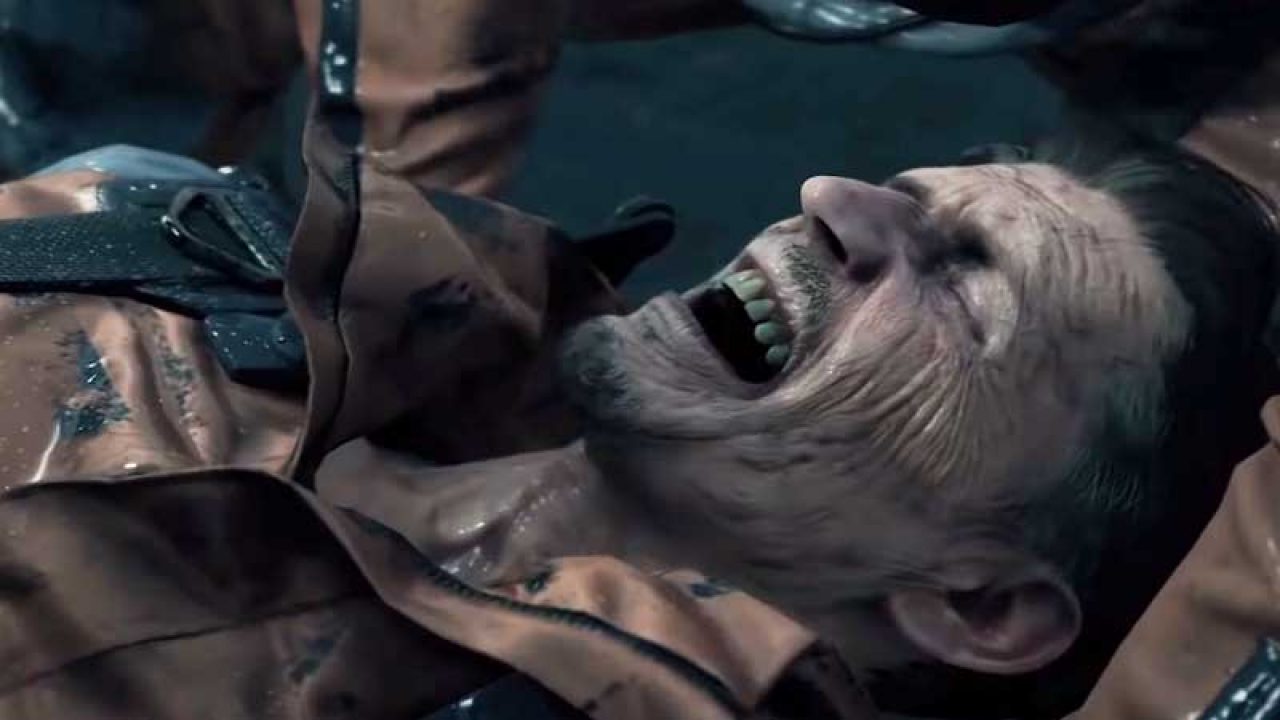
Pacing
One of Death Stranding’s biggest narrative flaws is bad pacing.
This is not a standard weakness for Kojima. I would go as far as to say that Metal Gear Solids 1-3 are very well-paced games. They are all story-dense without being excessively bogged down, and I’ve always thought they manage to achieve this rare quality of feeling simultaneously compact and epic. On the other hand, Metal Gear Solid 4 is overly-long and packed with too much cutscene-driven stop-and-starting, but that’s the exception that proves the world.
Of course, Metal Gear Solid V and Death Stranding present different pacing challenges due to their sizes and variability of game length. MGS 1-3 are about 8-12 hours, MGS 4 is 15-20 hours, but MGSV and Death Stranding are maybe 40-80 hours. This makes it far more difficult for Kojima to control the flow of the narrative. MGSV was rightfully criticized for an odd story structure which climaxed in the middle of the game and then sort of episodically drifted away afterward.
If anything, Death Stranding has the opposite problem. It’s pacing is what I would call “barbelled.” It’s far too fast in the beginning and end, and far too slow in the middle. At the two ends of the story, the player is hit with an excess of concepts, details, and plot developments, leaving him overwhelmed, confused, and with not enough time to process the emotional and thematic meaning of the story. But then the middle of the game is a vast expanse where very little of consequence in the story happens. Consider two points in the game:
First, Sam arrives at Port Knot City (west end of the east coast) where he’s confronted by Higgs in another great cutscene (3:15). This sets up the primary conflict of the plot – Sam drives west to rebuild America while Higgs opposes him.
Second, Sam crosses the tar ocean and arrives on the west coast. He’s close to the end of his journey, and Higgs once again confronts him, and this time shows that he has Amalie captured and under his control.
What happened in the game between these two points?
In terms of gameplay, a lot happened. In fact, the bulk of the game happened. The player connected all the cities, distral stations, and (probably almost all) the preppers between the east and west coast. By this point, the player likely has a good understanding of the movement mechanics, how to navigate BTs, how to get past MULEs, what tools he likes to use and which he leaves behind, etc. He has traversed about 90% of the game world and likely put a good 30+ hours into the game.
But in terms of story, very little happened, especially within the main plot. Sam is still trying to reach the last city on the west coast to rebuild America and rescue Amalie, and Higgs is still opposing him. Sure, some stuff happened – like Sam and Fragile stopping Higgs from blowing up another city, and Mama’s entire character arc, and fixing the glitch in the Q-pid, and a dozen prepper stories – but these are all sub-plots. They have little-to-no bearing on the main plot. Any or all of them could have been removed from the game without any significant impact on the story. I’d say that the only story events of real consequence to occur between those two points were Cliff Unger’s interventions and learning about the extinction entities from Heartman.
But then the beginning (chapters 1-2) and end (chapters 9-14) of the game have the exact opposite problem. The final chapters of the game are especially bad in this regard. There are so many revelations and plot twists packed into a few cutscene-heavy hours that there isn’t enough room for the story to breathe. I was feeling plot-whiplash as character motivations kept twisting and turning and I lost track of who was doing what and why.
I can’t help but chalk it up to bad storytelling when Kojima tried to pack so much story into so little game-space, especially right after a huge chunk of excessively light game space. Like, remember all the revelations at the end of the game about DieHardman’s identity and Higgs’s motives and Amalie’s grand plan… remember how they’re all thrown at the player over the course of an hour or two in a 40-hour game… why not space those reveals out a bit during the preceding 30 hours of the game where Sam just walks across the country?
I think Kojima struggles to read complexity. He tends to either make things too complex or not complex enough, and fails to ride the line between the two points. Speaking of which…
A Question of Complexity
I’ll cut Kojima a lot of slack for Death Stranding upfront because it is a hard story to tell. There’s simply a lot going on in the game. It tackles big original ideas and concepts with which the player has little familiarity. The scope of relevant narrative action ranges from individual character arcs like Sam’s all the way up to the literal fate of the universe with a variety of preppers, organizations, and the entire United States of America in between. Even the best of writers would have trouble wrapping all this up in a coherent narrative package.
The biggest challenge that Kojima-as-a-writer seemed to struggle with throughout the game was how to reveal information to the player. This is always a challenge for sci fi and fantasy worldbuilding – if too little information is revealed then the player is lost and confused in the narrative, but if too much information is revealed than the mystery soon vanishes and the world becomes a whole lot less interesting.
My take is that Kojima did a fairly bad job of walking this balance. Too many concepts in the game are underexplained, but at the same time, quite a few are overexplained.
For example, take the death stranding. This is the most fundamental worldbuilding concept in the game. It is the trigger for all the game’s events, the bedrock of the game’s world, and more-or-less the antagonist for the player. Yet after finishing Death Stranding for the first time, I still couldn’t really explain what the death stranding was. I think I got the gist of it (dead people’s souls are trapped on Earth and cause a lot of problems) and I could explain some important aspects of it, like timefall, but it all felt vague and slippery to me. I couldn’t actually give a full, coherent explanation of what the death stranding was, even though I had stopped it.
I don’t think this lack of understanding was due to my failure as a player (though that’s not impossible). And I also don’t think the nature of the death stranding was kept intentionally vague as a narrative choice. Rather, the explanations for what the death stranding is and how it functions are spread diffusely throughout the game and are easy to miss or forget.
For instance, much of what the player needs to know about the mechanics of the death stranding are shown in a single cutscene early in the game when Sam gets attacked by BTs and witnesses a voidout. This is Kojima’s directing and cinematography at its best, but it’s easy for the player to get so wrapped up in the scene’s intensity that he misses the deluge of crucial details. In rapid succession, the player is shown necrosis, the creation of a new BT, the movement and appearance of a BT, the way BTs react to humans and sound, the effects of timefall, a voidout, the seam, and repatriation. I, for one, couldn’t adequately process half of those details when I first watched it.
Granted, these concepts are stated later in the game, but usually either in passing during cutscenes or chiral network conversations, or it’s buried in the “interviews” and “emails” (which I’ll get to later).
For an example of the opposite problem (over-explanation), look to the end of the game after Sam is rescued from the beach. Deadman approaches Sam in the hallway outside the presidential room and gives a long, convoluted explanation of how he, Lockne, Heartman, and Fragile all worked together to pull Sam back to Earth (1:00:03 or 24:03). All I could wonder while watching this scene was… who cares? The lore mechanics here are not interesting or relevant to anything. Yes, the game made a big deal about Sam possibly being trapped on Amalie’s beach, but couldn’t the writer have just had Amalie (the most powerful being in existence) push Sam back to Earth rather than use this multi-tiered Inception-esque rescue operation?
This problem of over-and-under-explaining is greatly exacerbated by Death Stranding’s barbell pacing. The beginning and end of the game typically under-explain due to the sheer density of story points, while the middle of the game typically over-explains because there’s nothing else going on. The end of the game especially has so many crucial plot points which are quickly stated and moved past (consider how much of my Plot Summary section is communicated by Amalie in one scene on the beach). Meanwhile, the middle of the game is filled with looping conversations and explanations about how important “reunifying America” is and how to use Sam’s gadgets.
The result is a plot which bounced between annoying me with repetition and leaving me confused and asking…
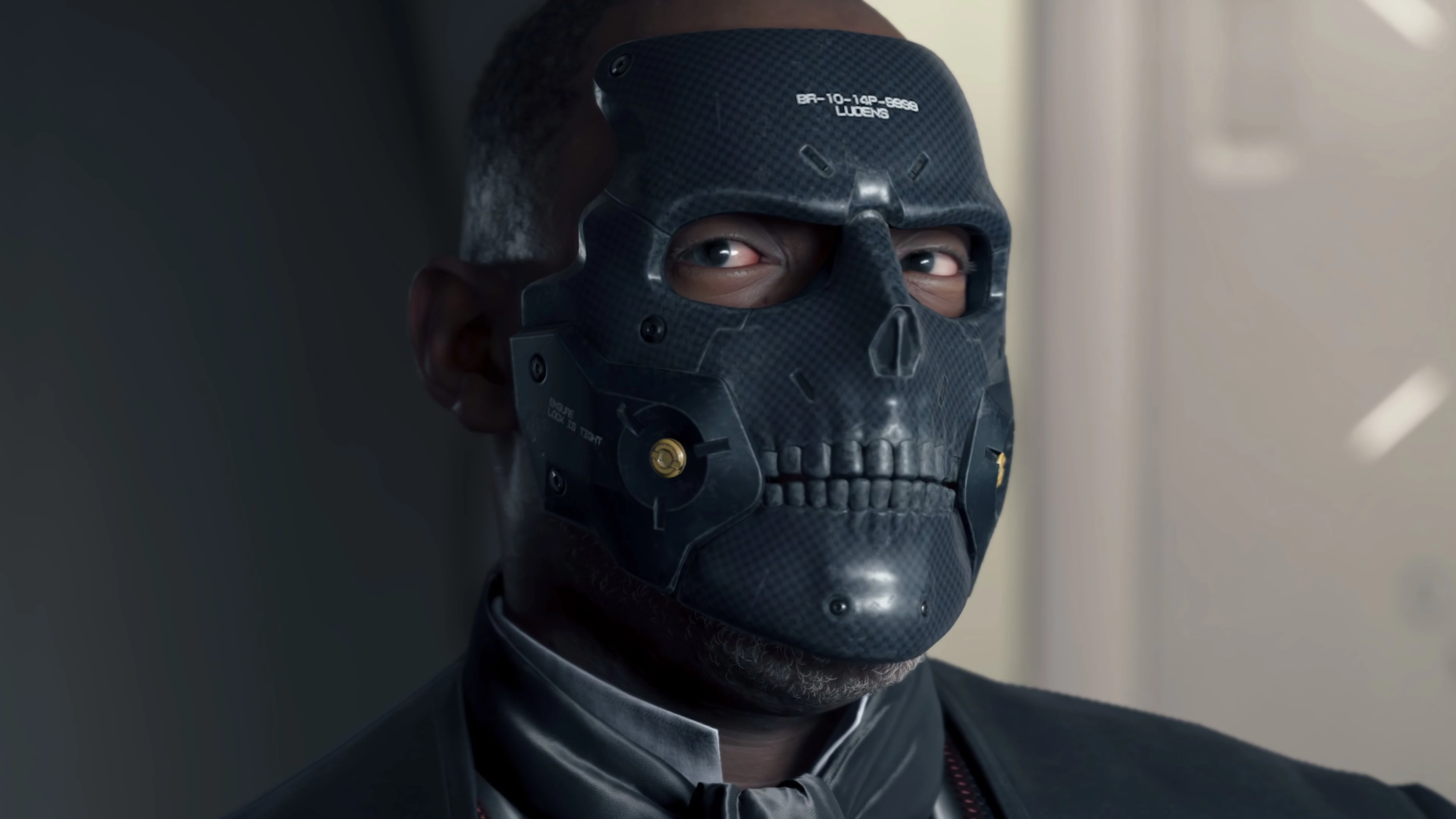
Seriously, What is Going On?
All this stuff I’m saying about Death Stranding’s failures with worldbuilding, pacing, complexity, explaining, etc., are really just the hidden flaws of the game. They are the problems under-the-surface which cause the textual story to fail.
When I first played the game, I let a lot of the plot wash over me without thinking about it. I often didn’t understand what was going on, but I assumed I would eventually. But upon replaying the game… I never did. So much of Death Stranding’s plot simply doesn’t make logical sense.
To illustrate, let me dive into an extremely long in-depth look at my least favorite scene in the entire game (starting at 21:00 here, and ending at 3:15 here.). Here is what happens:
Higgs kidnapped Amalie and is holding her on her own beach. Fragile sends Sam to Amalie’s beach. Higgs tells Sam that Amalie is an extinction entity that can destroy all of humanity. Sam defeats Higgs and rescues Amalie. Fragile shows up on the beach (conveniently after the fighting is over), and Sam hands Higgs over to her.
Amalie reveals that she was never really held captive by Higgs or terrorists, and that she just pretended to be to lure Sam into building the chiral network. Sam is pissed off, but seems to forgive her.
Sam and Amalie run along the beach so they can teleport back to the east coast, but then they come across DieHardman aiming a gun at Bridget. Diehardman says that he was finally invited to the beach and (using information given later in the game) that he’s using the gun used to kill Unger to now “kill” Bridget. He says:
“You were supposed to make the world whole – not fuck it all up.”
Bridget seems totally ok with getting shot, so Diehardman shoots her. It has no effect. Bridget says:
“There is no atonement, not for us.”
Bridget points to the ocean where Unger and his skeleton soldiers emerge. Diehardman falls to his knees and starts whimpering. Unger takes off his mask, then stands up and aims his gun at him. But then Unger smells something in the air, moves past Diehardman, and points his gun at Bridget. He demands his BB back. Bridget points him toward Sam (who’s holding Lou) and Amalie. Unger and his soldiers start moving toward them. Amalie pushes Sam into the ocean and he falls back to Earth.
I have played through this entire game twice, I have gone through the forums, I have read the interviews and Death Stranding Wikipedia, and I have no clue what is happening in 80% of this scene. Any semblance of coherency to these events is entirely undermined by information given to the player in later scenes. Literally nothing that Amalie, Bridget, or DieHardman do in this scene makes the slightest bit of sense. I defy anyone to provide a coherent explanation for what any of this means or why it happens. Let’s start with DieHardman:
It literally hurts my head trying to work out what’s going on with DieHardman. The player isn’t supposed to understand what he’s doing at first, but then after this scene, Deadman shows Sam a recording where DieHardman says (46:34):
“Alright. This message is insurance in case something happens to me. For Bridges eyes only. And I sure as hell hope that’s who’s watching. I got a little present from Amalie. Said she’d take me to the beach if I wanted. But I need this doll to show me the way. It’s a trap. It has to be. But I’ve decided to play along…”
DieHardman then reveals that he dug through archival data revealed by the chiral network and discovered that Amalie doesn’t exist in physical form and that he doesn’t know who or what Amalie is, but… “if she’s the cause of the death stranding, I have to accept her invitation… I’m gonna stop what she started… by stopping her.”
So DieHardman infiltrates Amalie’s beach to kill her. But he points a gun at Bridget and says, “Remember this? It’s the same gun. And now I’m using it to make things right. You were supposed to make the world whole – not fuck it all up.” He shoots Bridget a bunch of times, but it has no impact. Then Bridget summons Unger, and DieHardman cries and doesn’t do anything.
Ok, so…
First, what is this “trap” DieHardman is talking about? What does Amalie/Bridget have to gain by inviting DieHardman to the beach, either as an ambush or non-duplicitously? This is never explained in the game.
Second, why does DieHardman try to shoot Bridget when he intended to kill Amalie? Remember, DieHardman doesn’t know they are the same person. He explicitly says that he doesn’t know what Amalie is.
Third, why does DieHardman think he can “kill” a “ka” (AKA soul) on the beach, assuming that’s what Amalie is? There is no indication anywhere else in the rest of the Death Stranding world that this is possible.
Fourth, it’s extremely unclear whether DieHardman knows that Bridget/Amalie caused the death stranding. Does the “it’s the same gun” line only refer to the tragic killing of Unger, or the creation of the entire death stranding?
Fifth, since DieHardman doesn’t have DOOMS, how does he expect to return from Amalie’s beach after killing her? And no, it wasn’t meant as a certain suicide mission, because he leaves the audio message as an “insurance policy” in case he doesn’t come back.
Sixth, if Amalie really is an extinction entity, the most powerful being in existence which is capable of manipulating dimensions and causing mass extinctions via antimatter, then why the fuck does DieHardman think he can kill her with a revolver on her own beach?
None of this makes any sense!

From DieHardman we can leap to Unger for the next bit of insanity.
Through Unger’s portion of the story is one of the best-told bits of Death Stranding his actual reason for being in the narrative is remarkably thin. Amalie eventually says that she brought Unger back to Earth to show Sam that he wasn’t abandoned as a child. Ok, whatever. Then why the hell is he in this cutscene?
It looks like Bridget/Amalie summons Unger to confront DieHardman, but… why? It can’t be for protection since we see that DieHardman can’t hurt her with his gun. Is this the “trap” DieHardman worried about? If so, why??? What does Amalie/Bridget gain by throwing DieHardman in front of the man he feels guilty for helping kill? Keep in mind that the only reason DieHardman helped kill Unger was because Bridget ordered him to! So… did Bridget/Amalie set a trap to make DieHardman feel guilty about doing something that he did at the behest of Bridget/Amalie? What the fuck is going on?

Finally, let’s loop back to Bridget/Amalie for one more bit of total nonsense.
We know that Bridget is the “ha” (AKA body) and Amalie is the “ka” (AKA soul) of the same person. Yet, they function as two separate entities which work together. Bridget dies, so Amalie is all that’s left. But later, at the end of the game when Sam confronts Amalie for the last time, we see that Amalie can take Bridget’s form on the beach. So we can assume that in this scene the Bridget we see on the beach is really just Amalie and that Amalie just happens to have the power to be in two places at once, or at least she has that power on her own beach.
Fine. Whatever. But…
Why does Amalie do all this bullshit in this cutscene? Isn’t she the most powerful being in existence? Didn’t she give Higgs his DOOMS powers? How can Higgs possibly be strong enough to kidnap and posses her? And what’s the point of this “trap” for DieHardman? What does she gain from it?
Better yet, why does one part of Amalie summon Unger and send him after Sam (she literally points to him) while the other part throws Sam off her beach to get him away from Unger?
What. The. Fuck.

Again, I’m not just ripping on this scene for fun. I devoted 1,500 words to it because it represents all that’s wrong with Death Stranding’s storytelling. There is so much going on, lots of big concepts and character motivations flying around, and though it’s easy for the player to get swept up and just accept what he’s seeing, after a moment of thought it all turns to nonsense. And I didn’t even mention how cringey the Sam-Amalie beach run is (2:40).
And this isn’t a cutscene for some random subplot; this is a crucial scene that sets up the climax of the game. This sets up all the pieces and players for Sam’s confrontation of Amalie on her beach with the fate of the world at stake. And it’s an absolutely terrible set-up.
To me, this cutscene exemplifies so much of the game. The big picture worldbuilding concepts basically make sense and fit together, but the plot and character interactions underneath that are all like this. It all exists in this confusing haze where characters say and do things that don’t make any sense after you think about it for two seconds. And thus it’s impossible for the player to get too invested in the game events because the stakes and motives are always so blurry.

Why Does Anyone Do Anything?
I need to give a second example of how confusing, convoluted, baffling, and nonsensical Death Stranding’s plot is. This one is too big to ignore…
Amalie and Higgs. I cannot get a hold on their motivations. I cannot figure out why they do the things they do throughout most of the plot. I’m convinced that Kojima got so twisted up in trying to straighten out their motives that he fell into plot holes.
Let’s start from the beginning:
Higgs was born in a prepper shelter and raised by an abusive uncle. When his uncle died, he gained DOOMS and some associated powers, and left the shelter to become a porter. He developed a sense of community as he served other preppers and eventually teamed up with Fragile Express to unite much of middle-America.
Higgs met Amalie on her cross-country Bridges expedition. Amalie was leading Bridges to build a chiral network across America so she could connect more beaches, thereby giving her access to more data from biological history, which would hopefully help her stop the next extinction. For never-explained reasons, Amalie took a liking to Higgs and revealed to him her true nature as an extinction entity and what caused the death stranding. She also gave Higgs incredible DOOMS powers, including the ability to control BTs.
All of the above is clear and is mostly explained in the Interviews. But everything else about the relationship between these two characters doesn’t make sense. Basically, the player is given two contradictory explanations for how Higgs and Amalie fit together.
Explanation 1 –
Higgs was a depressed misanthrope. He wanted Amalie to fulfill her destiny as an extinction entity and kill everyone. However, Amalie had spent her entire life trying to gather data to stop the extinction event (see here, 50:18). So Higgs flipped out, betrayed Amalie, and decided to use the DOOMS powers she gave him to force Amalie to end the world (see here). Hence, Higgs tries to stop Sam from building the chiral network so America stays divided and civilization continues to decline. At the end of the game, Higgs kidnaps Amalie and uses some sort of DOOMS-powered mask to posses her. But Higgs is defeated by Sam, turned over to Fragile, and left on the beach to commit suicide. Ironically, shortly after Higgs’s death, Amalie explores the newly available data on the chiral network, discovers the evolutionary benefit of the extinction events, and then decides to trigger the extinction herself.
So under this explanation, Higgs spends the entire game trying to force Amalie to end the world, then after Higgs dies and Amalie is freed, she decides to end the world anyway. That’s weird, but whatever.
Explanation 2 –
This scene (1:00:46 or 24:00:46) with Fragile directly contradicts Explanation 1. After Fragile deals with Higgs on the beach, she meets with Sam and has this exchange:
FRAGILE: I had a little chat with Higgs back on the beach. Didn’t take much to make him talk.
SAM: He say why he betrayed you?
FRAGILE: He said that it was part of her plan.
SAM: What?
FRAGILE: She was their leader. The terrorist voidouts, the whole extinction agenda, Amalie was behind it all.
SAM: Like hell she was.
FRAGILE: I know you don’t want to believe it. But it lines up with what Diehardman said. Higgs turned on me [Fragile] after he met Amalie. At first he was looking to expand his territory and I had a power he could use. At least, that’s how he ended up working with me. He was no terrorist. He just wanted to reach more people. But then she shows up with abilities that puts mine to shame. Hell, she could even control BTs, so Higgs decides to go with her. And that’s when she turned him into her agent of extinction.
SAM: Amalie gave Higgs his power?
FRAGILE: Yep. She made him her homo demens.
Skipping ahead a bit…
FRAGILE: There’s this idea that Bridges brought back BB tech and the terrorists followed suit. It’s garbage. Their methods and yours are completely different. Your BB links you to the world of the dead. Their doll links them to Amalie and her beach.
So according to Fragile and Higgs, Amalie created the homo demens terrorists with Higgs as their leader. They all worked together to try to trigger the extinction event (which Fragile calls the “extinction agenda.” It is confirmed in other cutscenes that the homo demens terrorists got BB tech from Amalie, and we know that BBs were initially studied so Bridget/Amalie could better understand the afterlife and beach network.
A lot of the information Fragile presents is super confusing because it’s hard to reconcile with Higgs’s background presented through his journal Interviews. For instance, Fragile says that Higgs got his powers from Amalie, but Higgs had DOOMS powers before he met Amalie (see here). So Fragile must have meant that Higgs got stronger DOOMS powers from Amalie, which is suggested by his journals (see here). Also, there were homo demens before Higgs turned evil (see here).
But whatever, let’s just assume those minor discrepancies can be reconciled. Even so, if everything Fragile says of is true… that means that Amalie created both Bridges and the Higgs-led homo demens. She made one organization dedicated to building the chiral network, and another organization dedicated to destroying the chiral network. Why…? What did Amalie have to gain from the homo demens? What could they do that Bridges couldn’t?
Better yet, why does Higgs do any of the stuff he does throughout the entire game? If Higgs is working with Amalie to cause the extinction event, and Amalie wants to build the chiral network, then why does Higgs keep trying to stop Sam? And why does Higgs eventually kidnap Amalie?

Seriously. There is no way to reconcile these explanations. The game simply contradicts itself. In one scene Amalie says that she was always trying to figure out how to stop the extinction event until the chiral network was completed and then she changer her mind, but in another scene Fragile reports that Higgs was always working with Amalie to cause the extinction event. So which one is true? Was Amalie always trying to cause the extinction event or not?
If Amalie wasn’t trying to cause the extinction event, then did Higgs just totally lie to Fragile? Was all this stuff about Amalie creating the homo demens and giving them BBs bullshit? Alternatively, if Amalie was trying to cause the extinction event, then why the fuck did Higgs do everything in his power to stop Amalie from achieving her goals? Did he keep trying to murder Sam and nuke cities for a laugh?
None of it makes sense. The central motives of the primary antagonists of the game are nonsense!
Again, like so much of Death Stranding’s plot, I didn’t notice this problem when I first played the game. I found it confusing, but I didn’t know enough story details to judge for myself if it made sense. Now that I’ve spent a decent amount of time understanding the nooks and crannies of the story, I can confirm that so much of it doesn’t make any sense.
I’m almost done tearing into Death Stranding’s plot, but I need to tackle a few more minor issues, including one that really annoyed me…

There is A Massive Continuity Error in This Scene (1:44:02)
This might seem extra-petty, but it has bothered me since I noticed it.
Clifford Unger gets shot while holding the BB tank containing his son. He lies on the floor bleeding out while saying his final words to Sam about how being a father made him braver than ever. Bridget picks up the BB tank, looks inside and sees… GASP! The BB is gone! The camera pans over and we see Cliff holding Sam outside of his BB tank!
Except… Sam was very clearly in the tank only seconds ago. And there was no way Cliff could have removed him from the sealed chamber while bleeding on the floor after taking several gunshots to the chest while a small crowd gathered around him.
Seriously. Watch the scene. It’s ridiculous.

Emails and Interviews
The interviews are ok as a storytelling device. They tend to be repetitious and have way too much fluff, but they convey some crucial information to the player and help fill in the blanks or reinforce details presented throughout the game. There’s some good worldbuilding hidden in them which I wish had come out through the main plot, like how America’s birthrate has collapsed. During my first playthrough, I really looked forward to receiving interviews from getting more stars at delivery locations.
The emails are awful. Oh, are they awful. I cannot describe how stupid they are.
They’re just really dumb. They all sound the same, they are all badly written, they all incongruously use idiotic emojis, there are way too many of them, they describe boring subplots of boring characters they player doesn’t care about, and I find their entire inclusion in the game baffling.
Why, why, why are they written like that? Is everyone in the Death Stranding world a hyper-caffeinated 12 year old girl? Why are there so many emojis? Why?? Why does every email, regardless of which of the dozens of random characters wrote it, sound exactly the same?
And why do they always gush with bubbly praise for Sam? Speaking of which…

Thank You, Sam
*Sam delivers a case of fuel*
“OH MY GOD! IT’S SAM BRIDGES! THE LEGEND! THE LEGENDARY PORTER! THE MAN WHO HAS BEEN REUNITING AMERICA! OH MY GOD THE FUEL CASE IS ONLY 19% DAMAGED! THAT’S INCREDIBLE! THE LEGEND DOES IT AGAIN! HOLY SHIT!!! THANK YOU, SAM! THANK YOU SO MUCH! WE DON’T KNOW WHAT WE’D DO WITHOUT YOU! THANK YOU! OH MY GOD, THANK YOU!”

Dialogue
Dialogue has never been one of Kojima’s strengths, especially not its translation to English. Super Bunnyhop’s analysis of Metal Gear Solid 4 paints a history of Kojima always being the big picture storyteller of the series, but steadily gaining control over minute dialogue and translation decisions as the games became more popular, much to their detriment.
In MGS1, external translator Jeremy Blaustein pretty much rewrote Kojima’s script to adapt a lot of the Japaneseness and Kojima weirdness for Western audiences. In MGS2, the external translator had to fight Kojima on every word and openly disparaged him as a terrible writer. Then Kojima’s writing partner on MGS 1-3, Tomokazu Fukushima, quit during the early stages of MGS4 and Kojima was creatively unbound, so to speak. Hence the (IMO) significantly weaker, wordier, more tonally dissonant dialogue of MGS4. I have no idea if this was by design, but I thought MGSV’s dialogue was a significant improvement, partially because it felt streamlined and better edited, and partially because there was simply less of it.
Comparatively, Death Stranding’s dialogue feels like a bit of a regression. It’s not as bad as MGS4, but it is worse than MGSV. Which is mostly to say, it’s wordier than the former, but not as wordy as the latter.
At its best Death Stranding’s dialogue is functional enough to be elevated by a good cast, especially Reedus, Mikkelsen, Baker, and Qualley. At it’s standard, the dialogue always has this slight uncanniness to it where characters never quite speak or react like regular people do, which I suspect is mostly a failure of translation. At its worst, the dialogue is repetitious (though again, nowhere near as bad as MGS4’s endlessly loopy conversations) or cringey.
For the worst bit of dialogue in the game, I point to Fragile smacking down Higgs (5:39):
HIGGS: Fragile…
Fragile: Guess I left a lasting impression. I’m Fragile… but I’m not that Fragile. This time you’re the one who’s going to break.
HIGGS: Is that right? I think you’ll find our bond is made of stronger stuff. (Higgs reaches out towards Amalie and tries to absorb psychic powers or something.) Give me power, dammit.
FRAGILE: Oh, what’s this? You’re already broken.
HIGGS: What the fuck!? I’m Higgs! I’m the particle of god that permeates all existence. What are you? Honey, you ain’t nothing but damaged goods.
(Fragile punches Higgs in the face)
FRAGILE: You’re damaged goods.
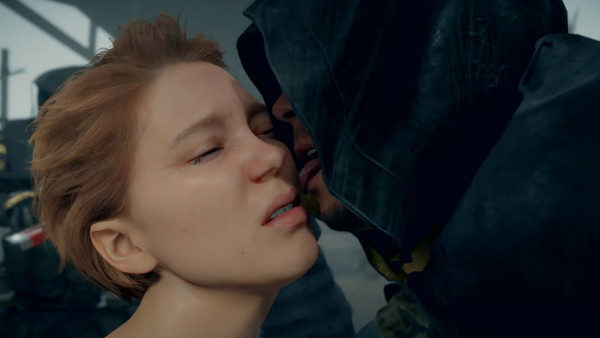
Kojimisms
I’m going to try to coin a phrase – Kojimisms.
Kojimisms are plot points usually hidden deep in a Kojima game story which are extraordinarily weird and are either extreme contrivances or plot holes. The player usually accepts Kojimisms unwittingly, but the second he stops to consider them, they become so bizarre that they’re difficult to comprehend or evaluate. I guess Kojimisms are a type of fridge logic.
A few of my favorite Kojimisms from the Metal Gear Solid series include:
- Metal Gear Solid 1 – Liquid Snake’s master plan is to allow Sold Snake to reach Metal Gear Rex to inadvertently activate it. So then why does Liquid Snake keep sending the Foxhound Commandos to fight and die against Snake? Why does he send Psycho Mantis, Sniper Wolf, and Vulcan Raven to their deaths? Why does Liquid himself try to kill Snake with a Hind D?
- Metal Gear Solid 2 – Solidus Snake is the former president of the United States. That’s just bonkers. Solidus Snake is a clone of Big Boss, who is considered the greatest terrorist of the modern age. So that’s like the IRL United States electing a president who looks identical to Osama Bin Laden.
- Metal Gear Solid 3 – The Pain picks the worst spot on Earth to attack Snake.
- Metal Gear Solid 4 – NANOMACHINES!
- Metal Gear Solid V – Ocelot knows the big twist in the game but he hypnotizes himself so he forgets it… what? How does someone hypnotize himself?
Kojimisms aren’t necessarily bad. They are part of the Kojima’s charm; it’s never clear whether any particular Kojimism is bad writing or just a bizarre little product of Kojima’s madness. Sometimes they’re fun, sometimes they’re fucking stupid. For better and worse, Death Stranding is packed full of Kojimisms. For instance:

MULEs
MULEs are former couriers who become so addicted to the thrill of delivering packages that they go feral. They leave behind their former jobs and lives to live in tents in the middle of the BT/timefall-ridden American wasteland so they can devote all their time to stealing packages from random passersby. They have no sense of community or civilization; they only care about getting packages.
This MULEs concept is so weird that it’s hard to describe how weird it is. I’m not even going to try. I’ll suffice to say that this is the type of thing that only Kojima could think of.
But as players have been pointing out since Death Stranding’s release, MULEs aren’t just random Kojima wackiness (or stupidity), but rather a surprisingly strong bit of thematic resonance. Because like so many other players who scoffed at the absurdity of becoming addicted to picking up and delivering packages, I became addicted to picking up and delivering packages.
That’s the magic of Death Stranding’s gameplay. It takes what is normally the dullest aspect of other games and makes it fun. I have probably spent 80+ hours just walking and driving around the game’s world moving supplies between cities. And I felt that little surge of anticipation with every pickup and little burst of satisfaction at every delivery, much like an addict.
This is a great Kojimism. It’s a bizarre concept which makes no literal sense, even in the crazy world of Death Stranding, but it works because it serves as a cool display of what the game tries to do with the player. It turns us all into MULEs.
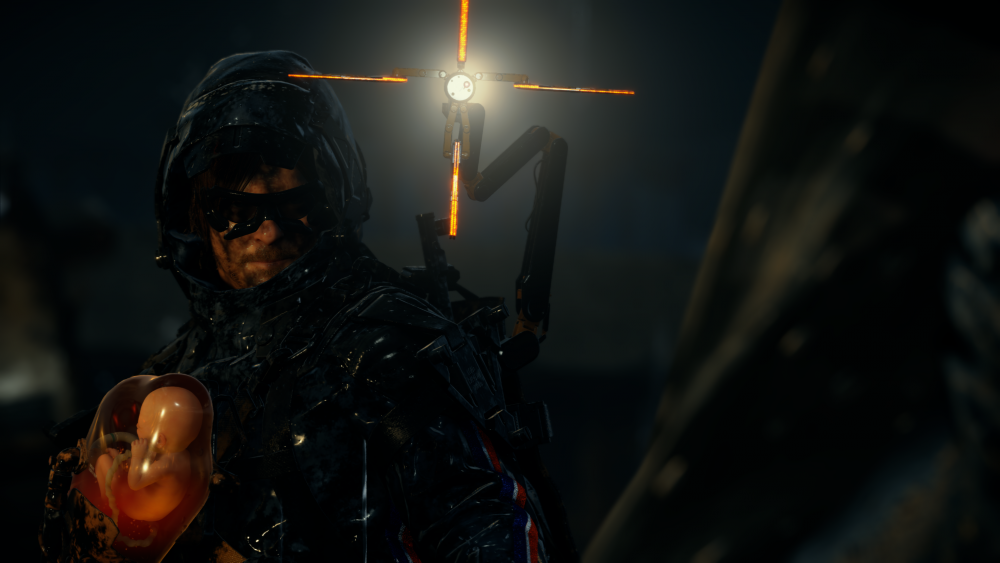
Acronyms Don’t Mean Anything
This isn’t a big deal. But still…
MULE and DOOMS are both supposed to be acronyms. But the game never tells you what the acronyms stand for. I doubt Kojima (or his English translator) bothered to actually come up words for each letter. They probably just thought they were cool-sounding names.

How Does Amalie Lead the First Part of the First Bridges Cross-Country Expedition?
There’s a big twist late in the game as Sam, Deadman, and Heartman conclude that Amalie isn’t a physical person on Earth. (Or rather, they say she isn’t “real,” which is very confusing because she clearly is “real” in some sense. She just isn’t a physically independent person from Bridget.) It’s eventually revealed that Amalie is Bridget’s soul trapped on the beach. Though Bridget’s body on Earth is dead, her soul lives on. Amalie can even appear on Earth via the chiral network, but she does not have a physical form.
If Amalie has no physical form and can only appear on Earth within the chiral network, then how did she lead the first part of the transcontinental Bridges 1 expedition to build the chiral network?
When I asked about this on a message board, someone suggested that the whole first part of the expedition was a made-up cover story, in the same way Amalie’s status as an independent person as Sam’s sister was entirely fabricated.
But this can’t be true because there is plenty of evidence of Amalie doing physical things on her expedition:
- She meets Higgs (confirmed in “Journal 10”)
- She meets Fragile (see here)
- She builds the groundwork for the chiral network. Most crucially, she sacrifices the bridge babies at distral centers, which Heartman and Mama (on the second part of the Bridges 1 team) don’t know about).
I don’t see any way to reconcile this plot hole without really diving into just-so speculation. Like, maybe Amalie herself wasn’t there, but random other Bridges members were, and they set up parts of the chiral network, and Amalie used those to meet Higgs, and the other Bridges members sacrificed the bridge babies and just didn’t tell anyone…
Or more likely, just as with Higgs, this is a case of Kojima laying out the story pieces and then not knowing how to mix them together.

Why is Cliff Unger in the Game?
Mads Mikkelsen is awesome and his scenes are great. The revelation of Unger being Sam’s father and how it pushes Sam to want to be Louise’s father is one of the best character moments of the game.
But Cliff Unger’s character doesn’t have a legitimate reason to be in Death Stranding. He could have easily been written out of the game.
Why is Cliff in the story? He’s brought to the beaches and Earth by Amalie, but why?
The answer – Amalie wanted Sam to know that he wasn’t abandoned by his parents.
(I wrote this down while taking notes during my second playthrough, but I neglected to put down when this happened in the game. If anyone knows the moment, let me know in the comments.)
So why didn’t Amalie just send Sam a bunch of files from the chiral network about his real father? Why summon Cliff from the afterlife?
If Amalie wanted Sam to meet his father, then why didn’t she use her seemingly limitless power over life and death to set that up in a more… amicable manner? Instead of, you know, unleashing a dazed ghost to repeatedly try to murder Sam.

Why Does Everyone Refer to Sam as “A Repatriate”?
This might sound like an incredibly petty grammatically nitpick, but it has a fairly significantly bearing on the plot.
All the characters in Death Stranding refer to Sam as “a repatriate.” This seems to imply that Sam is just one of many individuals in the world who have ability to bring themselves back from the dead. But as far as I can tell, Sam is literally the only repatriate. No other character in the game is a repatriate and we never hear about any other repatriates. And remember, the only reason Sam is a repatriate is because Bridget – the most powerful known being in existence – used her powers to revive Sam when he first died, thereby triggering the death stranding. Presumably, Bridget isn’t going around America saving other people from death and creating more repatriates.
I guess we can infer that Sam is the only repatriate in the world. So what?
So this means that the way other characters treat Sam is strangely subdued. Heartman, Deadman, etc. all note Sam’s repatriate powers and ask to study him, but no one treats Sam like he is literally the only human being on Earth capable of reviving himself from death. Given the nature of the death stranding, one would think that studying Sam’s singular abilities would be of the highest priority. Yet the Bridges crew treats Sam’s blood like a neat little tool for crafting anti-BT weapons, rather than the blood of Jesus. And isn’t Sam’s power especially relevant when he’s the son of the president?

Multiple Bridges
Sam is often called “Sam Porter Bridges.” Sam’s mother was “Lisa Bridges.” There is no connection between these two facts.
Sam is the son of Cliff Unger and Lisa Bridges. Sam is raised as a BB in a facility run by Bridges, a research organization founded by Bridget.
When I first realized the Bridges-Bridges connection, I assumed that Bridget named her Bridges after Lisa Bridges out of guilt for stealing her son or something… but no. The Bridges organization already existed before Sam was born. It’s just a completely random coincidence.
Or more likely, Kojima just really likes the bridge/strand thematic imagery and couldn’t stop himself from using it over-and-over.
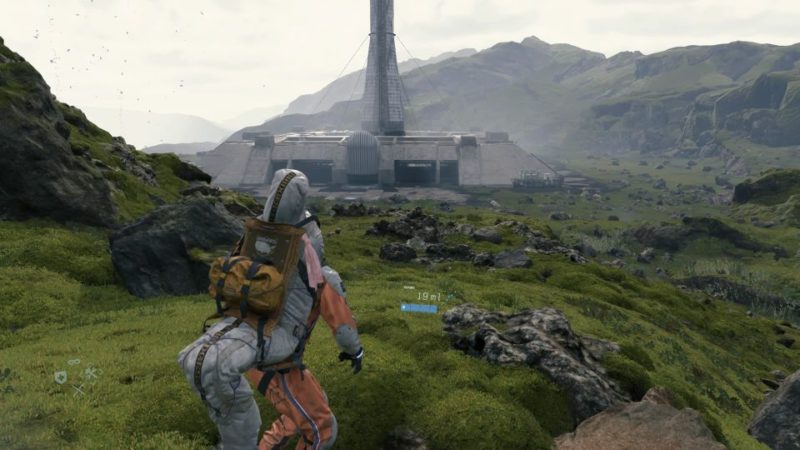
What’s the Point of Cremating Bodies?
Bridges makes a big point out of cremating dead people. There are crematoriums built throughout the game world. One of the first missions has Sam escorting a corpse disposal unit to a crematorium. They get attacked, a BT causes a voidout, and an entire city is destroyed.
Why does Bridges cremate bodies? What’s the point? Yes, when people die in the death stranding world, they necrotize and turn into BTs unless they’re cremated. But so what? There are already a bajilion BTs in the world and 99.9% of humanity is already dead. It’s not worth taking a long, dangerous journey to a crematorium to stop one more BT from coming into the world. Why not take dead people out of cities and dump them a few hundred yards away?
When I’ve posed this question on forums, some people have answered that dead bodies eventually voidout. This is false. Voidouts are caused by BTs consuming living bodies. We see this in the cutscene where Sam travels with the ill-fated corpse disposal group. Some people point to the voidout caused by Sam’s wife’s suicide as evidence that dead bodies voidout, but this is mistaken as well. Though I don’t think it’s directly stated, the story implied that Sam’s wife and child died, turned into BTs, and then caused a voidout by consuming a living person in their city.
Having to cremate all dead bodies is a cool bit of worldbuilding and an interesting gameplay mechanic, but it doesn’t make any sense.

Evolving Via Antimatter Extinction Events Doesn’t Make Any Sense
At the end of the game, Amalie gives her whole explanation for why the extinction events happen. To reiterate:
She says that the Big Bang, which created all matter in existence, was a random incident that threw the universe out of balance, especially since it led to the creation of all life. So the universe is trying to destroy all life to return to balance. The periodic extinctions of all life are an evolutionary mechanism to force life to evolve so that it can become more resilient and survive the universe’s attempts to permanently destroy it.
Based on this understanding, she decides to trigger the extinction event, rather than try to stop it.
Not to get all scientific, but how would killing 99.99% of humanity with antimatter work with natural selection? Does Amalie think that the 0.01% of humanity which survives will be immune to antimatter? Or will the new civilization that emerges in the aftermath devote all of its resources to anti-antimatter technology? How come this sounds like a giant ass-pull of a theory?
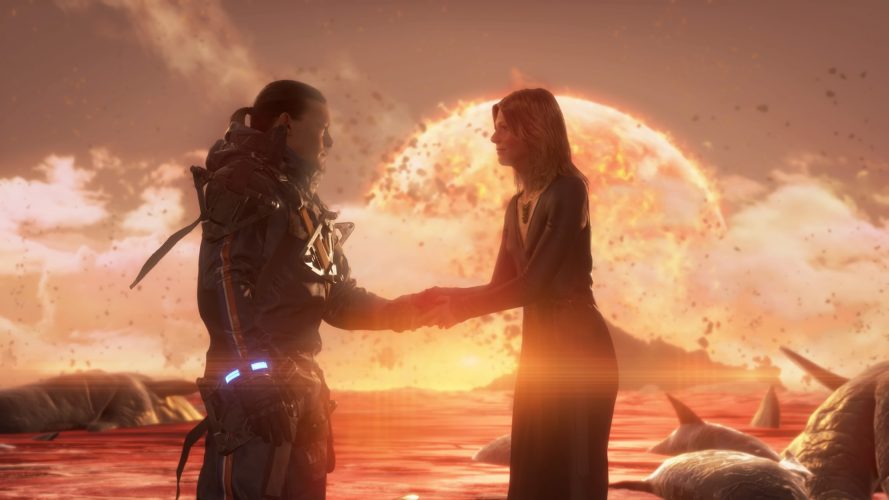
Why Does Amalie Need Sam Anyway?
Amalie wants to build the chiral network. She wants Sam to help her do it. Sam doesn’t want to do it. So Amalie does this whole convoluted plot where she pretends to be kidnapped and held by terrorists on the west coast, thereby incentivizing Sam to walk all the way across the country to save her while using the Q-pid along the way to build the chiral network.
Here’s a thought… why not just use Bridges and the homo demens (whom she secretly controls) to build the chiral network? She doesn’t need Sam. Yes, Sam is apparently a great porter and his repatriate powers make him special, but the actual chiral network building stuff is not a specialized task. Any porter or team of porters who can get from Point A to Point B would get the job done.
How is Sam a “Legendary” Porter?
This taps into Death Stranding’s larger problem with worldbuilding, but how does Sam become known as a “legendary” porter?
Sam leaves Bridges after the death of his wife. He then works as an independent porter for ten years and builds his fame. Throughout the game, UCA workers and eventually preppers are constantly amazed by Sam and call him a “legend.”
This doesn’t make any sense.
Prior to the start of the game when Sam doesn’t work for Bridges, for whom does Sam port? What other people or settlements or places need goods besides Bridges facilities? Yes, the preppers out west need deliveries, but Sam doesn’t go out west until the Bridges expedition during the events of the game. So does that mean that despite not technically being a part of Bridges, Sam still only does Bridges deliveries? If so, then he was never really gone from Bridges. Or does Sam deliver to and from other peoples in America who we never ever hear the slightest thing about?
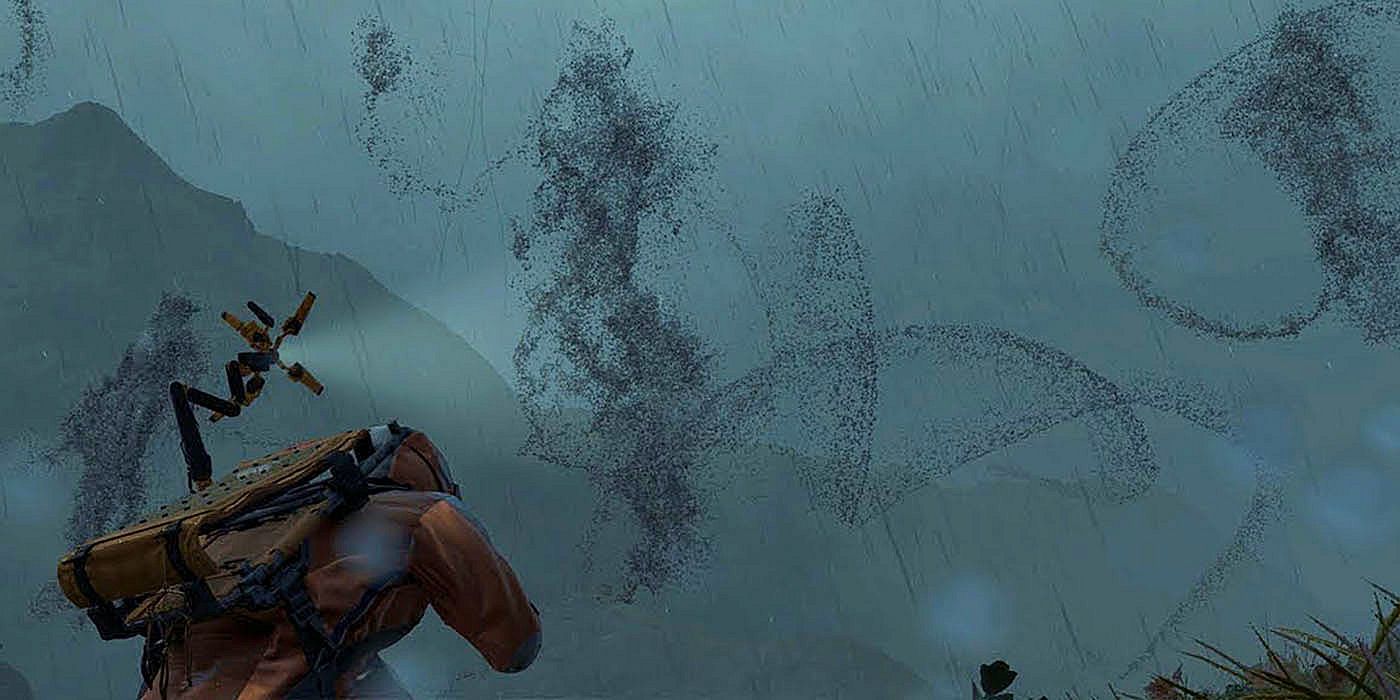
What is the “Death Stranding”?
No seriously. When characters refer to “death stranding,” I’m still not entirely sure what they mean. Sometimes “death stranding” seems to refer to an event, but other times it refers to an era.
What most confuses me on this point is the subplot about the Q-pid being faulty, and Mama + Lockne needing to fix it. At one point, Mama tells Sam that the problems with the Q-pid and chiral network are causing chiralium spikes which might “cause another death stranding.”
But isn’t the world already in a death stranding? How can there be another? Could there be a harder death stranding? Maybe more chiralium gets to Earth and causes more problems?

Do Animals have Beaches?
Let’s follow the logic:
The periodic extinction events are caused by a flood of antimatter flowing from the afterlife into the extinction entity’s beach, then into all other living being’s beaches, and then to Earth.
Bridget says that she discovers this because she explores a whole bunch of beaches and finds that lots of beings all died at the same time. Heartman and other researchers later find umbilical cords on animals in fossils, which indicate that these animals were extinction entities for their eras.
So… doesn’t that mean that those animals had beaches? If so, does that mean that all the animals living in America during the events of the game have beaches too? Does that mean that all animals turn into BTs when they die? What about bugs? Microorganisms? Or alternatively, did animals in the past have beaches but for some reason animals in the present don’t? How does any of that work?

What Were the Odds of Discovering Older Extinction Entities?
Ok, this one is nit-picky, but still…
In the Death Stranding universe, there is presumably only one extinction entity at a time. Bridget was the one out of seven billion people on Earth.
So how do Heartman and the other Bridges scientists manage to find five other extinction entities in fossil records? Of all the animals that have ever existed on Earth, what are the odds that those five, specific individual animals were fossilized and discovered in the present day?
And for that matter, if the extinction events consist of antimatter flooding into Earth and causing a massive voidout (or series of voidouts), then why are there any remains of animals at all? Should every past animal have been wiped out of existence?
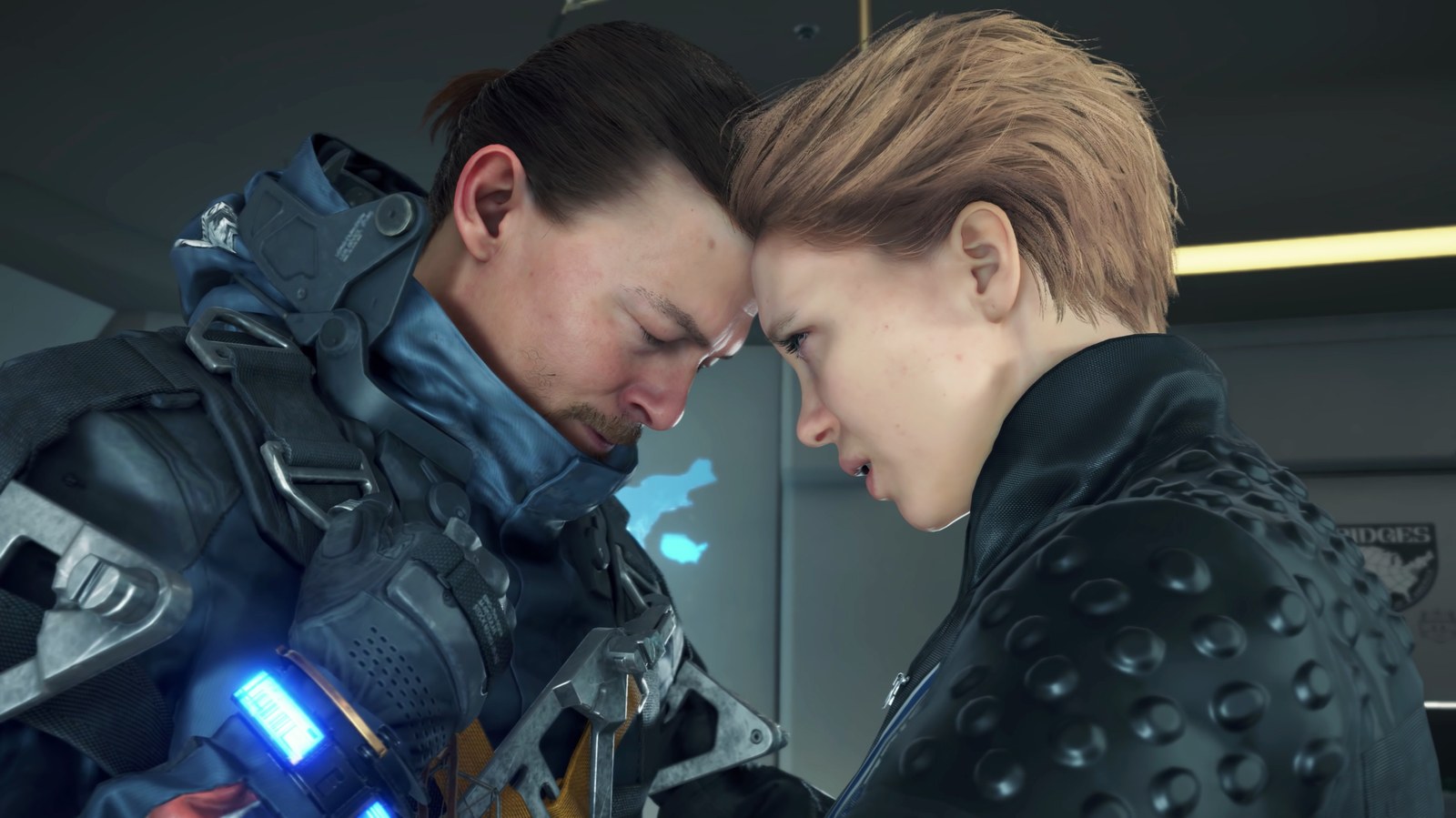
Thematics – Thin Strands
Kojima deserves immense credit for creating a giant AAA adventure video game where the player’s focus is shifted away from combat, violence, and defeating opponents, and toward making connections. This foundational shift is similar to the one Kojima made so many decades ago when he decided to design his first video game around avoiding enemies rather than killing them, thus birthing the stealth genre with Metal Gear. I hope Kojima pushes this trend forward by either continuing to expand on his “strand-like” genre, or by continuing to dig up entirely new game paradigms. That is Kojima at his best.
I just wish all the themes in Death Stranding – strands, connections, bridges, ropes, sticks, etc. – weren’t so shallow.
I find the thematics of Death Stranding especially frustrating since Kojima clearly cares deeply about themes. He centered each Metal Gear Solid game around a central thematic concept (ie. meme, gene, scene, etc.) which is reflected in their stories, characters, and gameplay. For instance, MGS2’s theme is “meme,” and thus he wrote a story based around the control of information, and the protagonist is a supersoldier crafted by the replication of ideas rather than genes (ie. Solid Snake), and the player navigates the game world by remembering the ideas replicated from past Metal Gear games, etc. Thus Kojima puts a degree of meaningful thematic depth in his game rarely matched by other game developers, especially outside of the indie scene.
Far before Death Stranding’s release, Kojima was tweeting and talking in interviews about the nature of “strands” and how humanity developed via the “rope and stick” and all sorts of fun abstract takes on life. Kojima seems fascinated by the idea that connections between individuals are the driving force behind progress. He’s interested in exploring how to gamify bringing people together when the vast majority of games are based on defeating others (usually through combat). He conceived Death Stranding as an exploration of this concept – a video game entire based on (mostly) peacefully building a community both of characters within the game world and real-life players in our world.
For the most part, I think Kojima succeeded. He designed a game entirely around peaceful unifying mechanics which are shockingly fun. He wrote a story which (incoherencies aside) motivates the player to bring something together through productive activity rather than destroying opponents. Again, Kojima deserves a ton of credit for all this.
But… I still find the themes of Death Stranding disappointingly shallow. It’s not clear whether Kojima purposefully chose to tackle the themes in this manner, or if he genuinely doesn’t think about his big idea with any real complexity.
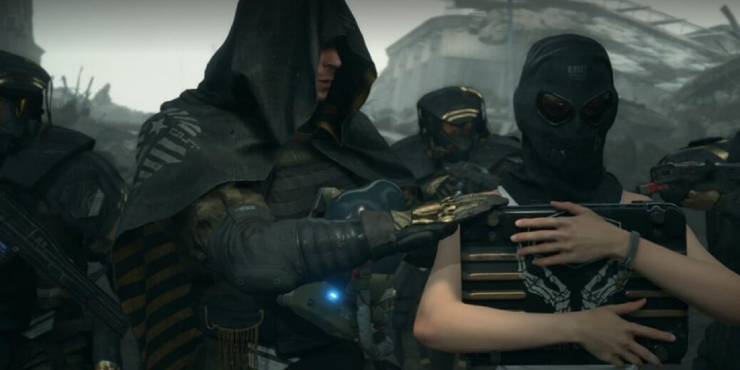
Homo Demens
After the preppers, the homo demens have the most disappointing pay off in Death Stranding.
They’re introduced to the player early on in the game when DieHardman is pitching the American reunification plan to Sam:
“There are extremists like Demens everywhere. Plotting in the shadows. They’re decentralized by nature. Not one organization to rule them all. Just a common ideology.”
He explains that these guys are “terrorists” and “separatists.” They are so opposed to the UCA that they slaughter innocent civilians to strike fear and prevent the unification of the American west. They even “engineer voidouts” as weapons, which sounds totally awesome, and uses the death stranding world in a novel and interesting way.
But of course, none of this goes anywhere. The player barely sees or interacts with any homo demens, let alone learns about their beliefs or fights an enemy which uses voidouts as a weapon. Instead the player is constantly told how big of a threat these guys are, how they’re always lurking in the background, how they’ve spread fear throughout the west, how they (led by Higgs) are the biggest obstacle to recreating America… and they end up doing almost nothing, either in the plot or gameplay. Just thinking about the disappointment gives me flashbacks to battle gear. I didn’t even realize those random guys shooting at me were homo demens until my second playthrough; I just thought they were extra-aggressive late-game MULEs.
I don’t really care about the gameplay in this case as much as the story, and especially the thematics. Death Stranding’s narrative is all about the value of coming together to make progress, so I thought it was intriguing that we had a villain who was ideologically opposed to this concept. I wanted to see how Kojima would grapple with the complicated moral, material, and strategic tradeoffs of binding people together. Or to take it up a notch, I’d love to see Kojima consider the relative value of centralization vs. decentralization.
Is it really that hard to paint a sympathetic case for the homo demens? Again, this goes back to the game’s complete ignorance of costs. Maybe there are very real downsides to joining the UCA. Maybe becoming just one of many cities in a country means giving up local governance power, or paying taxes, or making peace with sworn enemies, or having to spend more time working, etc. Maybe these costs outweigh the benefits of the chiral network, and porter access, and military protection… or maybe they don’t. Those are interesting questions to consider with no clear answers. Some people may be more inclined to the prosperity and security of the UCA; others might prefer the independence and flexibility of having no allegiance. The debate between these two viewpoints could be a fascinating explanation of what it really means to make connections between people.
In other words, the game takes it for granted that forging ties, centralizing, and surrendering authority to a unitary power is the right, good, and best thing to do. No consideration is taken for an opposing viewpoint. The only people who oppose these goals are homo demens, who are shown to be psychotic murderous terrorists, and whom we never learn anything about despite repeated references to an “ideology.”
What makes this particular lack of thematic depth all the more frustrating is that the game takes place in America, which is arguably the most decentralized country in the Western world. If there is anywhere on Earth where a sophisticated case against the alleged benefits of centralization has been made, it’s the USA. The choice between centralization and decentralization was the fundamental ideological struggle at the foundation of the American government. The Founding Fathers chose to cut the strands that tied them to Great Britain, and then had a massive multi-decade long debate between federalists and antifederalists over how closely the states should be bound to one another under a unified federal leadership.
There were brilliant people and great arguments on both sides of the debate. There were considerations of morality, statehood, economics, religion, and individual rights. There was a true struggle over complicated ideas regarding the fundamental nature and value of tying men together with the soul of a nation at stake.
And Death Stranding’s take on this epic historical/ideological debate is that bringing people together is always good, and produces incredible benefits that everyone will love, and has no costs, and the only people that would ever not want to be brought together are complete psychopaths. Like Thomas Jefferson.

I’m not saying that Kojima needed to take a super deep dive into the downsides of centralization, nor explicitly bring up American history. Nor was there anything wrong with taking a pro-centralization thematic stance. But to achieve even a modicum of thematic depth, Kojima needed to say something about the tradeoffs of his thematic position. The homo demens should have been better defined, the incorporation of preppers into the UCA should have been more difficult and encountered serious problems, members of Bridges should have questioned aloud if the reunification project was really 100% perfectly amazing, etc.
Instead, we got a rather saccharine and endlessly repetitious reinforcement of the same theme… UNITY IS GOOD. Everyone should come together. Everyone should be tied together. We should always use the rope, never the stick. Nothing else matters but ALL BECOMING ONE.
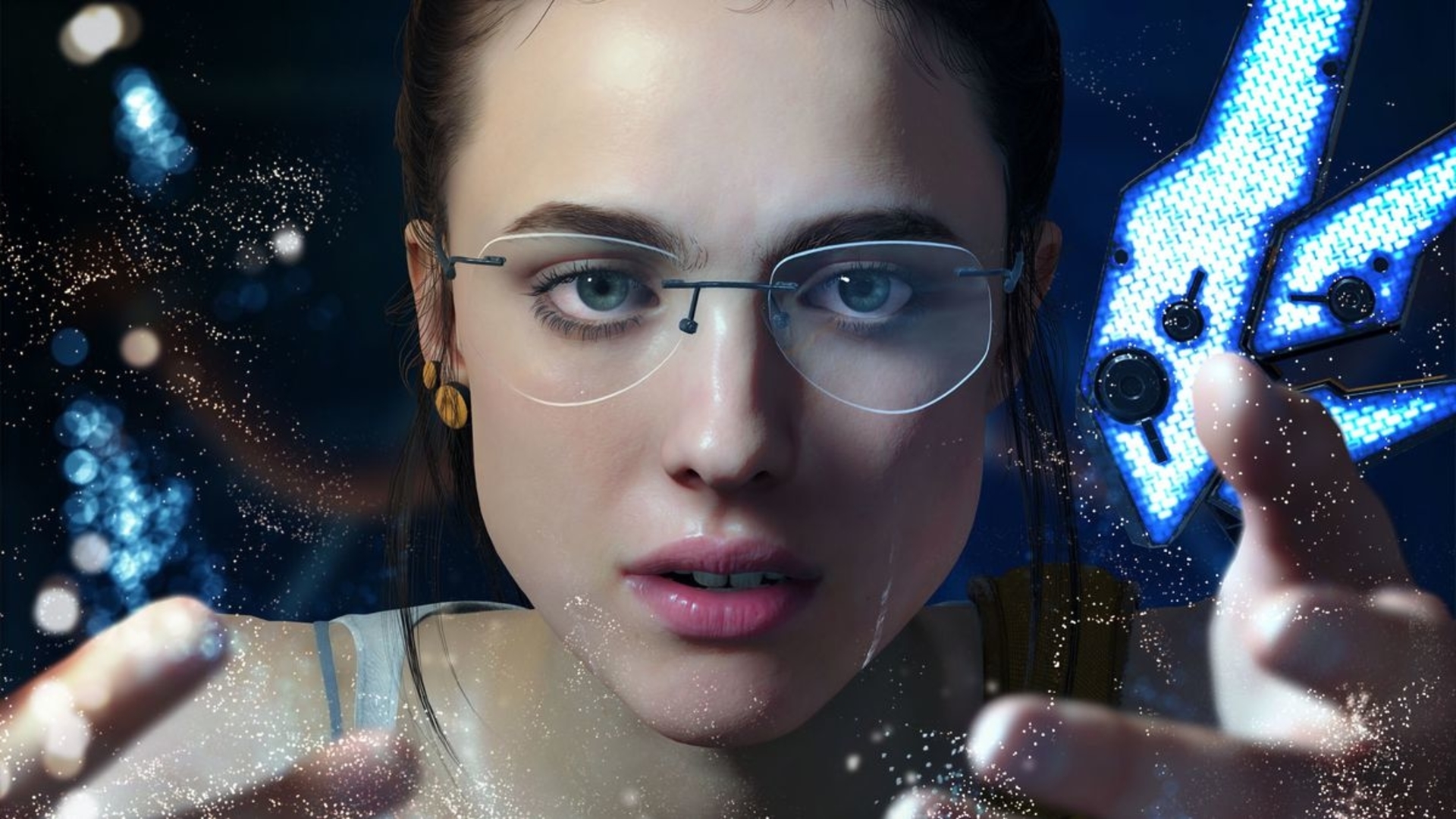
Hey, a lot of the YouTube links in this post don’t seem to go where you intended them to. Did you intend to put timecodes on them or something?
LikeLike
Yep, supposed to go to specific times. Damn.
I’ll fix em, thanks.
LikeLike
I have to make a comment… good stuff, but I feel like you missed out on a key piece of info: Amalie WAS a part of the physical realm for an amount of time after the NDE of Bridget. While I cannot remember which cut scene or interview i remember reading it in, i could have sworn that it was mentioned that Amelie originally spent time on earth after the split, but gradually began spending more and more time on the Beach (eventually causing the age gap).
She mentions “slipping out of here” and visiting Sam in the “do you still be believe in me” speech Fragile gets upset that you stay behind with Bridget after the Higgs fight.
Also, why would there need to be a cover story for Amelie at all if she wasn’t present around people from her creation , up to and through the majority of the 1st Expedition. It’d be safe to assume that until the age gap became too noticeable, that Amelie and Bridget may have traded off being “present” (especially when you take the Mask into account).
Again, I could be completely wrong, and am unable to argue my case any further due to the lack of the scene/interview where I swear they speak about how Amelie spent time on Earth but increased her time on the Beach until almost permanently.
LikeLike
I think you’re misremembering an admittedly very vague conversation in the game. I believe the “slipping out of here” referred to Amalie visiting Sam in his dreams. Sam says that he never saw Amalie in person during the cutscene where Deadman and Sam figure her out.
If you do happen to remember or stumble across the moment you’re thinking of, let me know.
LikeLike
But why would Sam accuse her of lying then say, “do you know what it took to get here,” referring to the fact that he came out west to save, what every body thought, for 9/10th of the game, was a physical Amelie? Why would he be mad about that if he knew that, the entire time, she was never going to be able to be physically brought back to CKC.
The entire context of Sam going west was that Amelie couldn’t leave the EKC, physically… so, Sam is sent out to fetch her and physically bring her back. So, when the revelation comes that she was able to “slip out” (teleport, Higgs-style) and visit him physically, he’s pissed because she could have, at any time, brought her self back to CKC.
With regards to Sam and Deadman’s convo, there was A LOT of hologram switcheroo’s in this game. So many times it’s mentioned, in the Safe Room scenes, who’s “really there” and who’s a “‘gram”. While Sam is seemingly OK with being touched by Amelie, there may have been a time where she teleported into his SR, early in the game, that we take her as being a hologram, but she’s really there, and never touched him to confirm. In fact I’d look at any scene where they don’t touch and where she is BAMFs out… does she leave behind the sparks/embers of somebody using the beach, or does she blink out like a ‘gram?
This leads me to believe that she’s been in physical form, and is capable of doing so at any time.
And trust me, I’m wracking my brain about that convo I can’t remember.
LikeLike
Sam did not know that Amalie had no physical form when he arrived in the West to save her. That reveal occurs when Sam gets to Lake Knot City on the edge of the East Coast when he’s backtracking to Capital Knot City. It’s then that Sam realizes that he had only met Amalie in his dreams.
Sam is pissed at Amalie when he rescues her on the West Coast and she reveals that she could “slip out” because Sam realizes that Amalie wasn’t really being held in captivity. So at that point in the story, he thinks that Amalie has a physical form, but also has the DOOMS power to “slip out” of physical captivity using the chiral network.
Yes, all of this stuff is super confusing and convoluted.
LikeLike
Ah, I see, I missed the layering there. It was more of a “never trapped”, not an ability to be present physically.
Well, unless I can find that specter of a memory I think i had… I can’t comment any farther. I will say that while I see your grand point about DS, I still think that this was an amazing game and what it lacked in themes being fleshed out, it made up for with affecting emotion. But, I realize that that can be subjective, so what I got out of the game, experience-wise will be different than anybody else.
Good read all in all.
LikeLike
With all sincerity and respect, I think there is a lack of points of view to understand the story the way you want to understand it. After all, and probably with a few exceptions, we only have the point of view of Sam and Lou. The rest is a lot of storytelling, assumptions, reports, lies, conjectures and suppositions. Just like in real life in fact!
As with all works, and especially with video games, it is often necessary to make concessions and it is a real challenge to bring so many people to work together on such a magnificent project.
In many of the works that I enjoy, I have discovered, often late, that nothing or very little is left to chance. At the most, it was left to interpretation.
I encourage you to look for answers to your questions even further, at the source if possible! I am convinced that you will find there a depth that you may not have imagined. Many of us will be listening to you if you do so with such expectation and exactness.
And I’m far from being a Kojima fan-boy, this is my very first Kojima game.
I discovered this game in the midst of a pandemic, my child had just been born, I became a father for the first time as family and friends left this world. Like many, I experience isolation and hardship.
Yes, you could say that Death Stranding resonated wildly with me.
I liked from start to finish the way I played it. It feels so good and brought me so much to the point of forgiving what may seem confusing.
That’s the way I decided to approach my experience with Death Stranding.
May you find yours.
LikeLike
I finished Death Stranding 3 days before you published this article but I only just discovered it today. After completing the game, I knew I had to read as much as I possibly could about it — hopefully by those more observant and articulate than I am — in order to better understand just what the heck I had experienced. It even motivated me to do a deep dive into the entire Metal Gear/MGS series, as I felt I needed to understand pretty much everything Kojima had ever done before.
The writing that I found on DS itself, though, mostly felt lacking. The YouTube video essays were a bit better, but I was (and still am) shocked at how little deep, thoughtful writing has appeared about this game, given what an intense and ambitious work of art is truly is. Finding your article literally renewed my faith in the internet! Such an incredible piece of work. THIS, this is what I wanted: well written, funny, insightfiul, extremely thorough and fair.
I appreciate that you first went out of your way to emphasize that you love the game for its many good aspects. That’s important for readers to keep in mind when you then go and list the hundred things about it that made no sense, seemed meaningless or just fell flat. I couldn’t agree more with your points, the vast majority of which I had not consciously noticed myself, nor read about before. So thank you for all that! I loved every word of it.
Two points that I wanted to discuss:
– At one point you ask why DieHardman thinks he can ‘kill’ a ‘ka’ (soul) on the beach when nothing else in the game hints that this is possible. But isn’t that exactly what is offered as possible when Amalie gives Sam the choice of killing her or staying with her on the beach, which happens (I think?) right before the scene with DHM?
– You explain Bridget’s research as discovering that ‘a chiral network on Earth could permit the easy transfer of material from the beach to Earth. This could help facilitate the transfer of antimatter from the afterlife, through the beaches, to Earth.’ But isn’t this mechanism what has caused previous extinction events, which Bridget has already decided to try to stop from happening again? In which case, wouldn’t she then be against expanding the chiral network?
Anyway, again, THANK you for this amazing piece of writing. I’m going to have to read it several more times to fully absorb it all, but already I feel like I have a much more soild understanding and appreciation for why I loved the game so much, and also simultaneously why I was vaguely frustrated and left feeling unfulfilled by so many of its details.
LikeLike